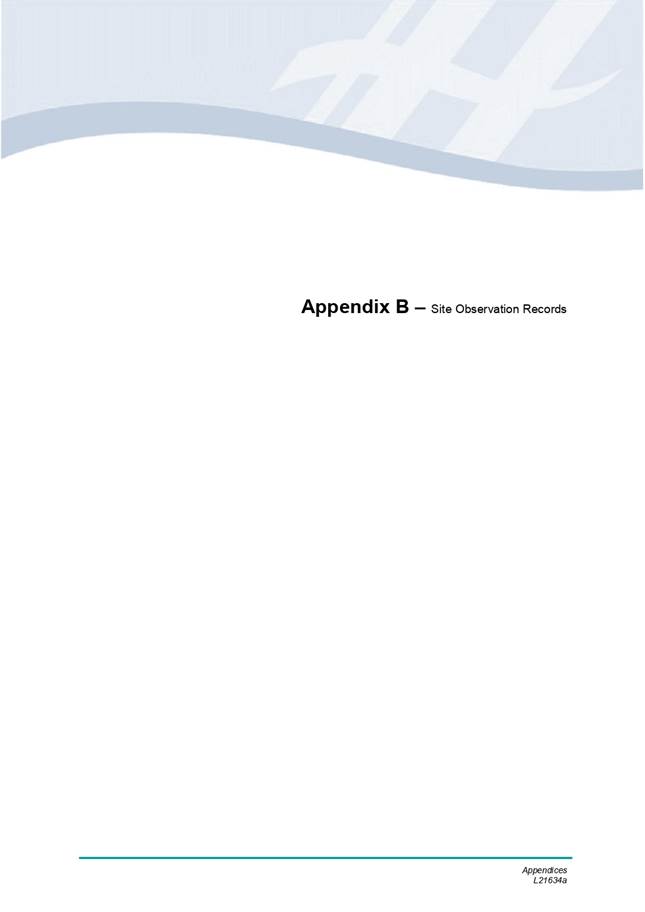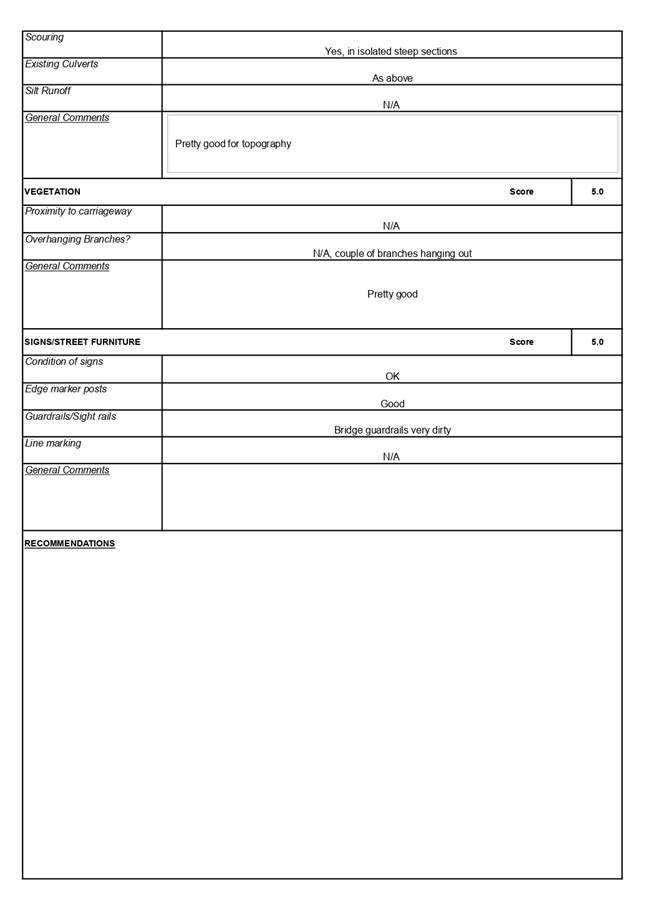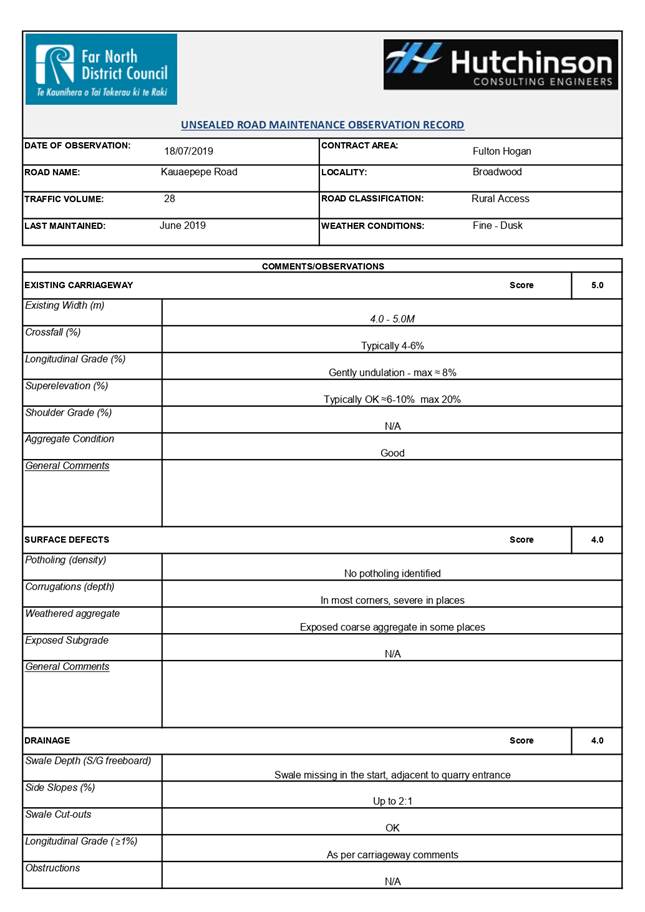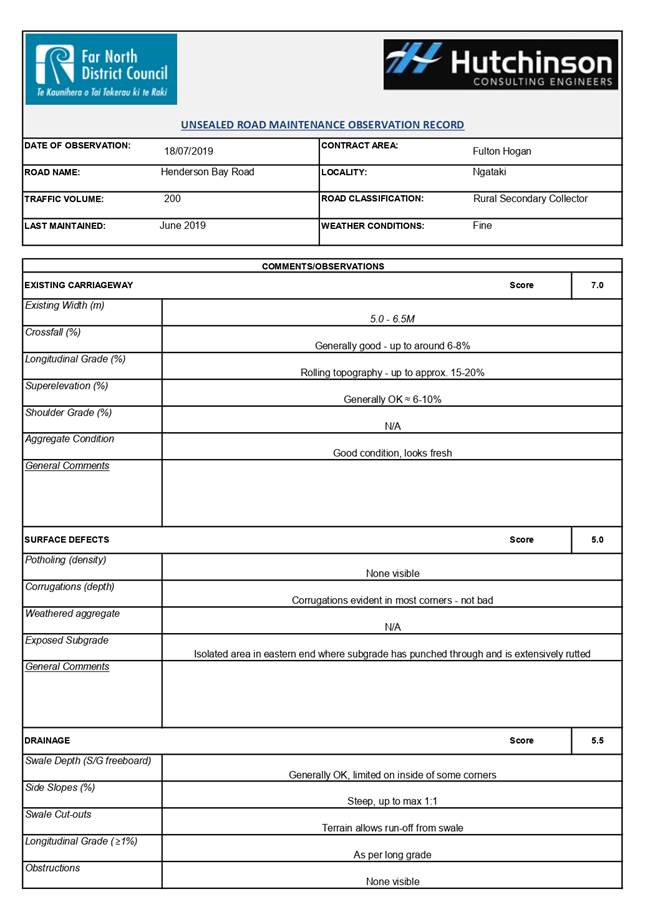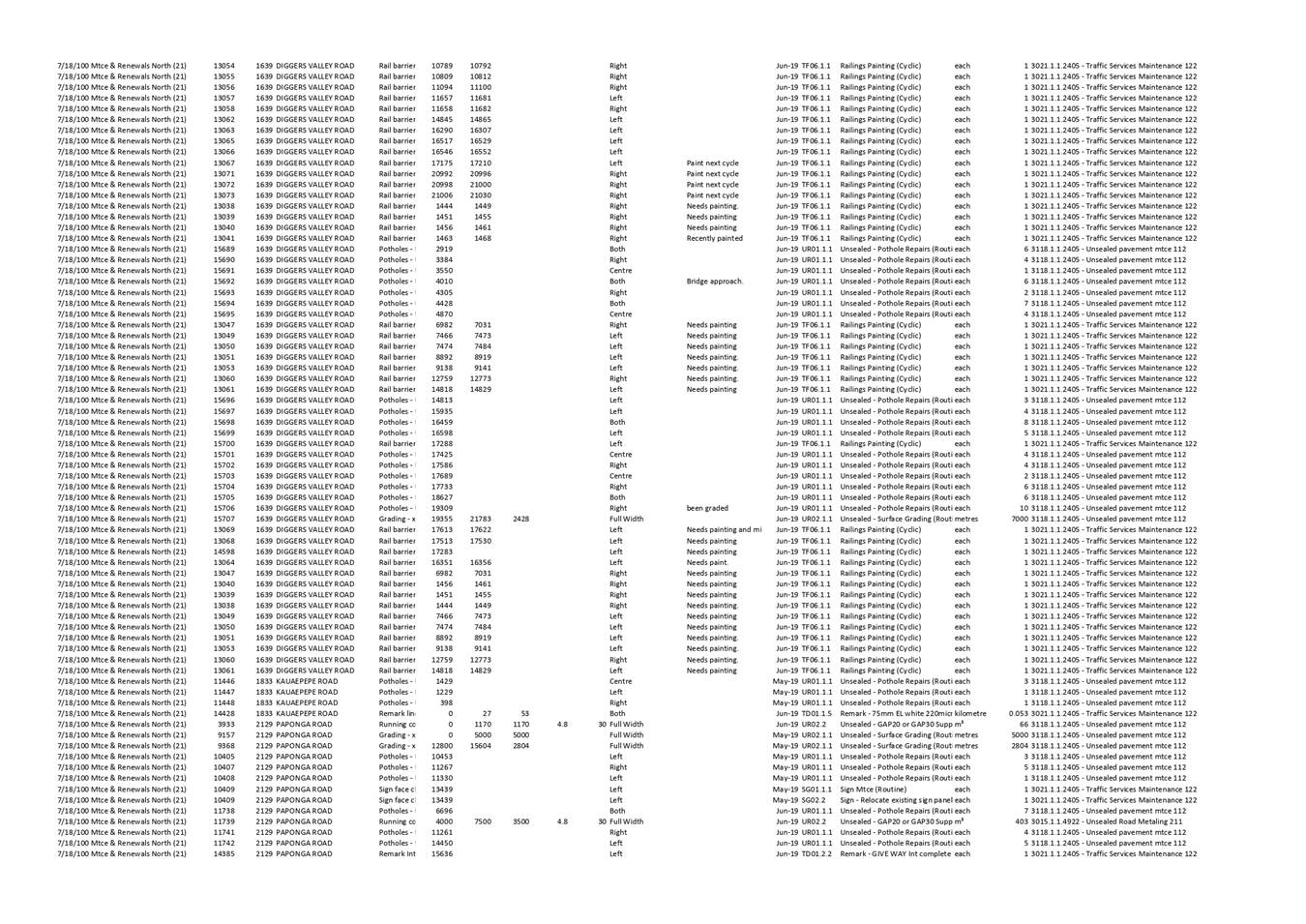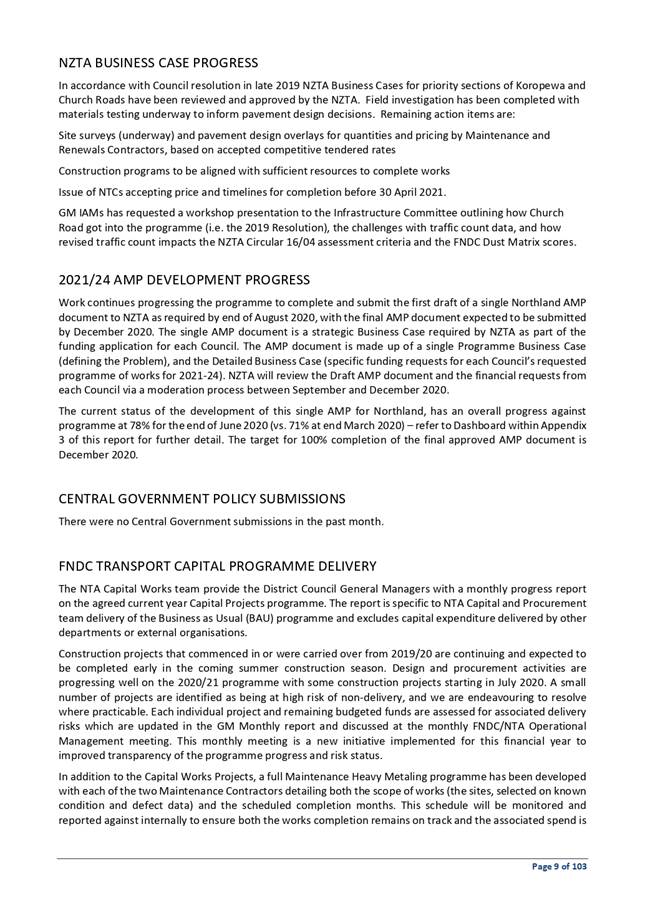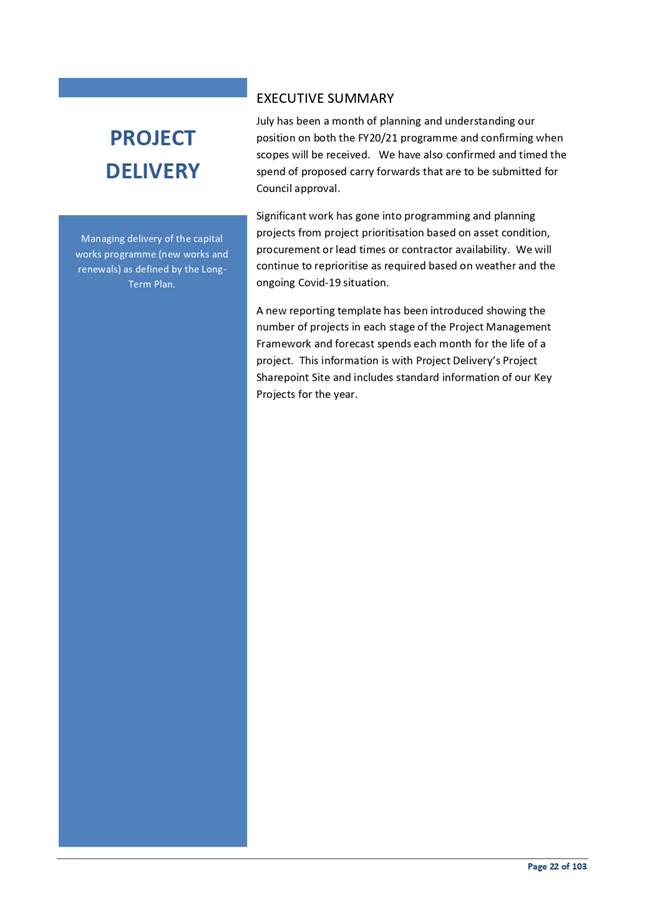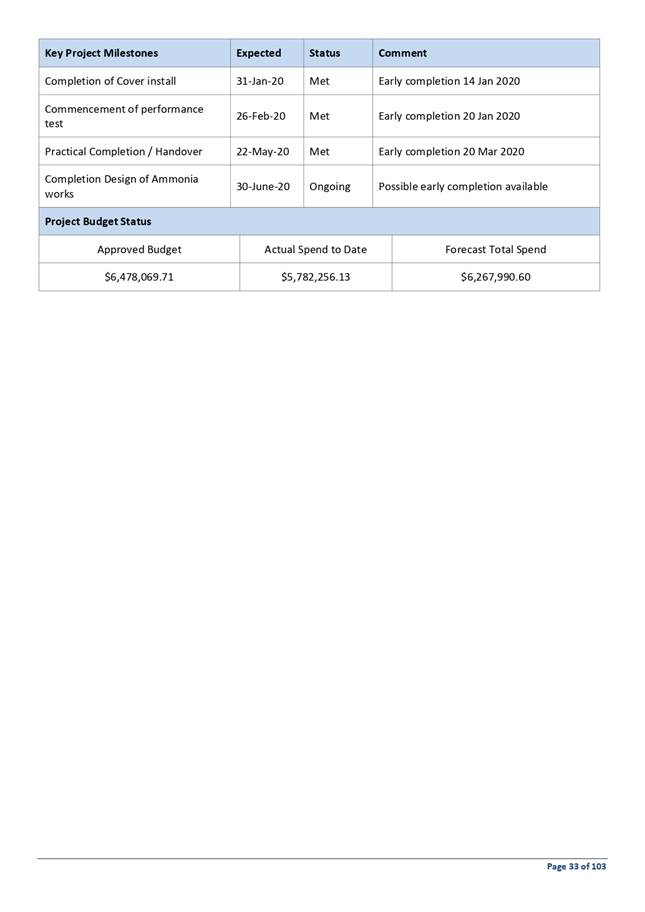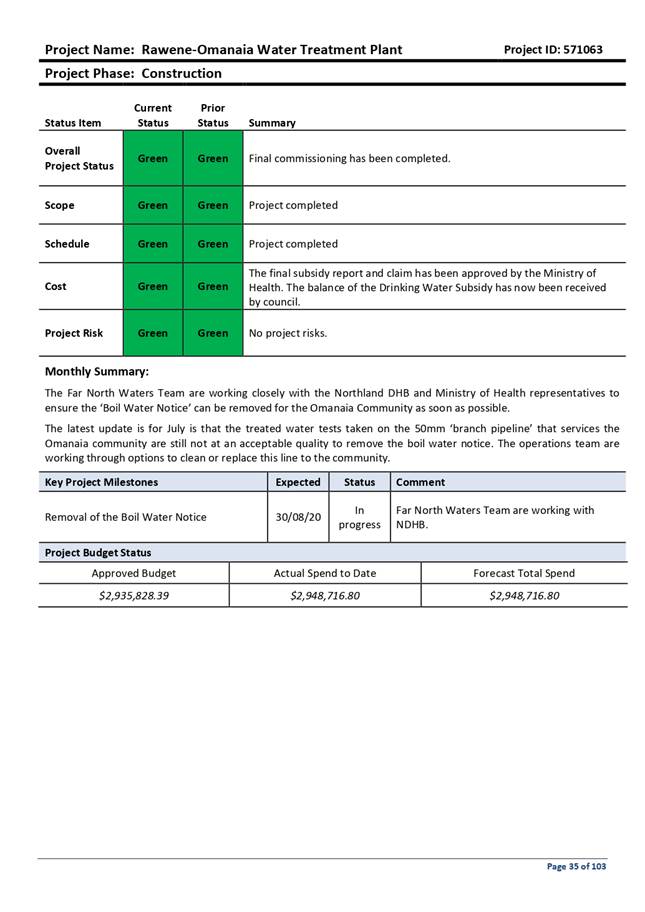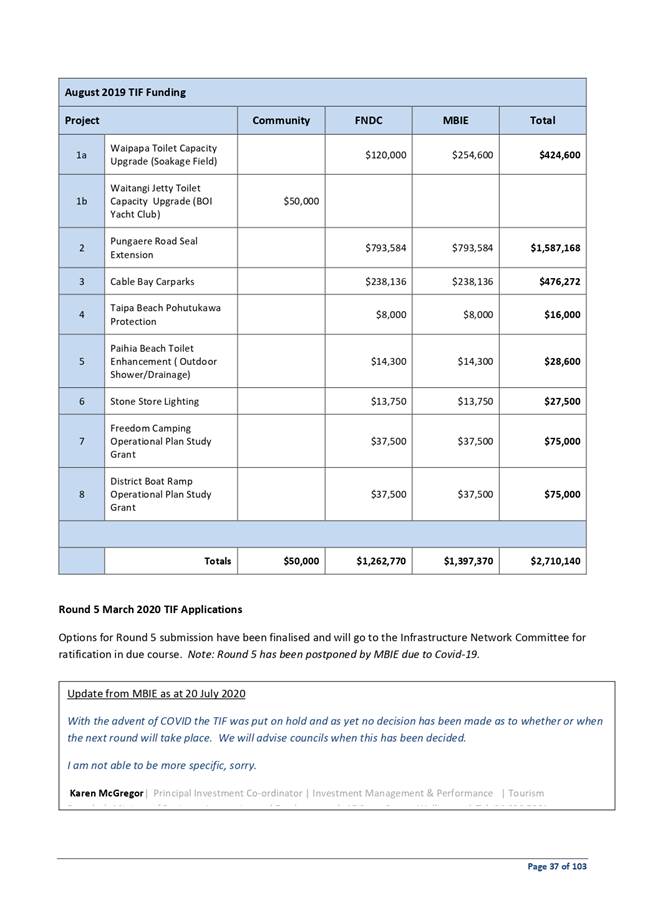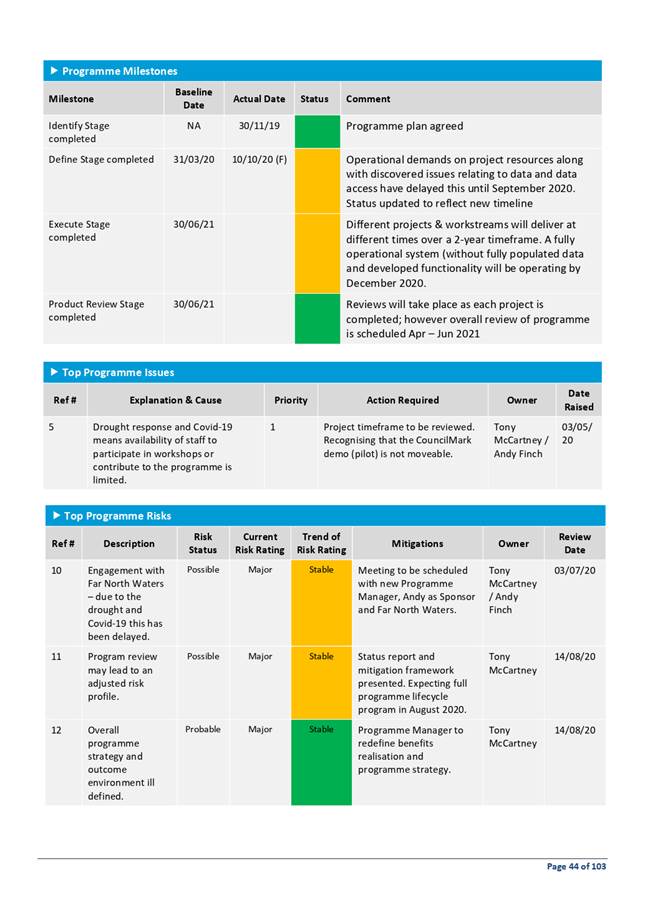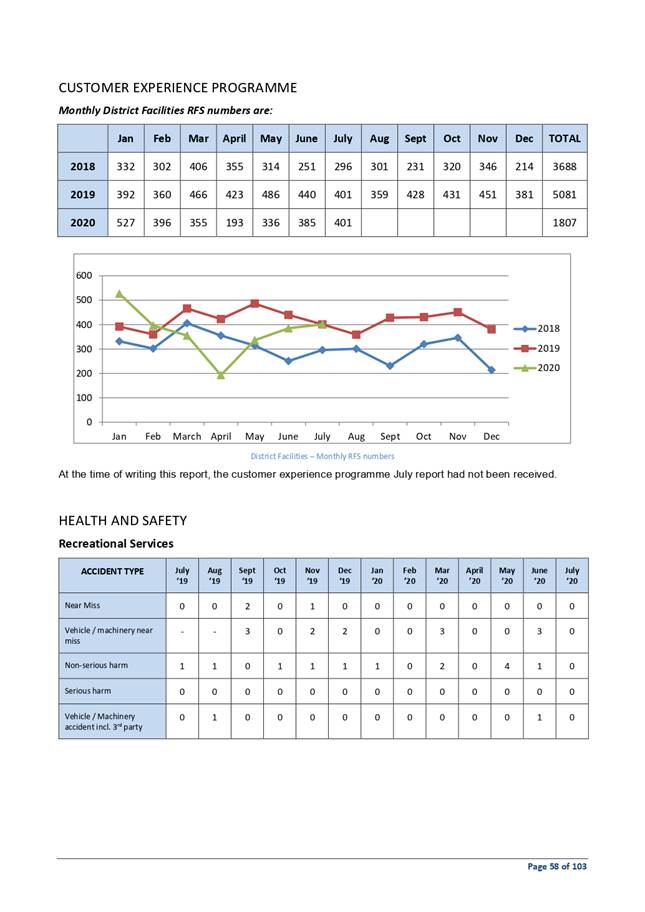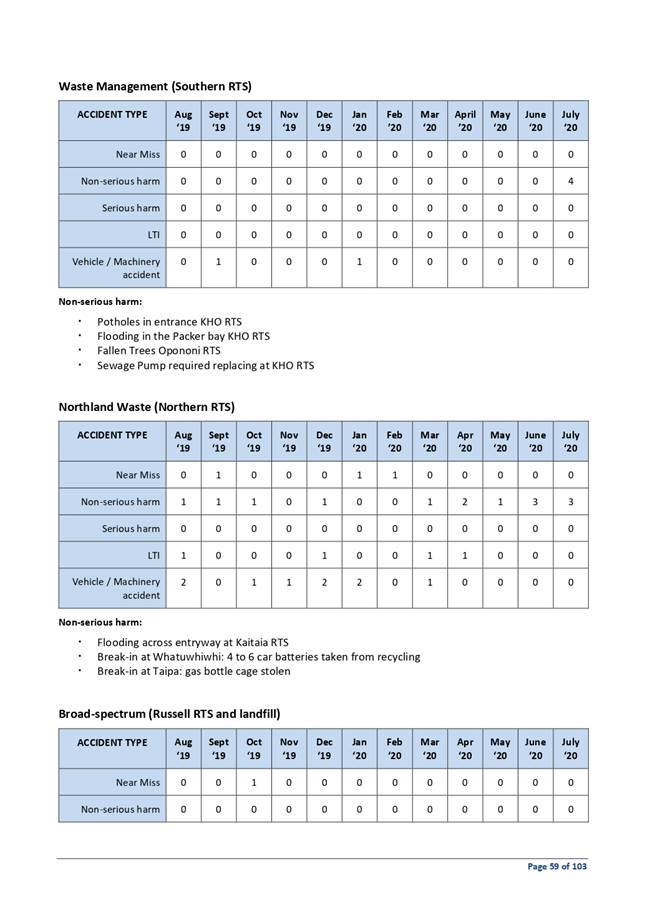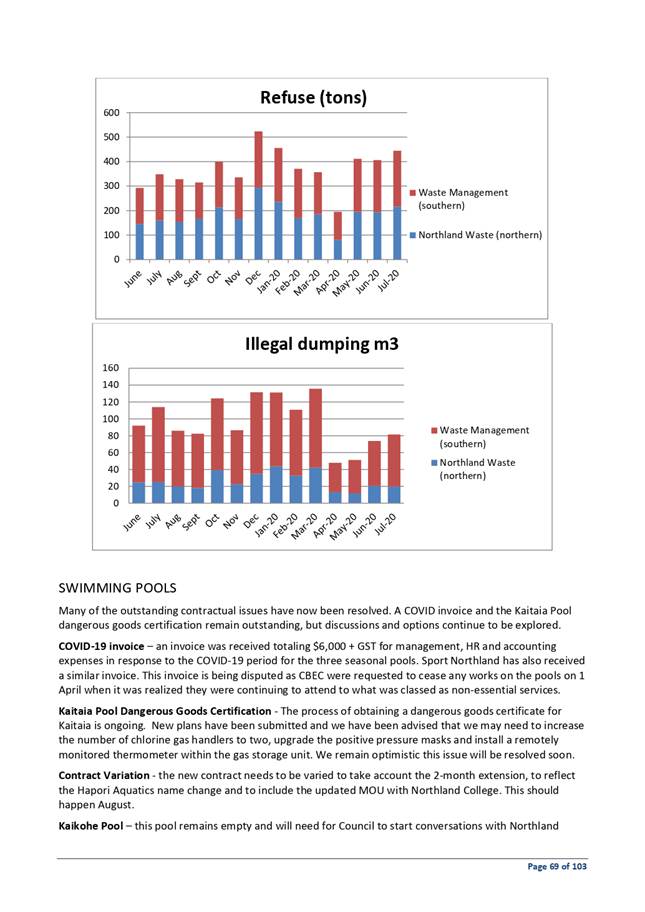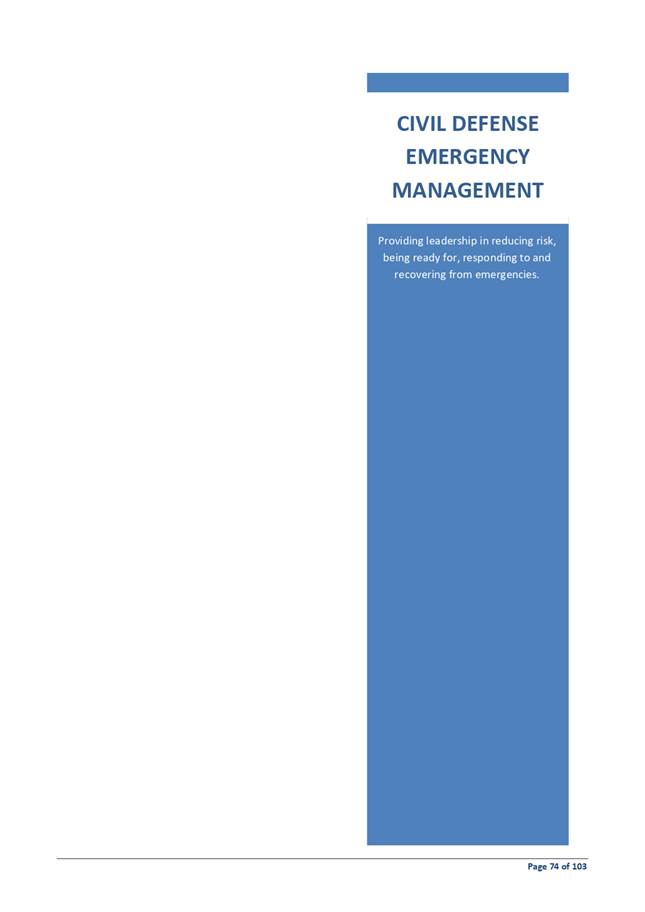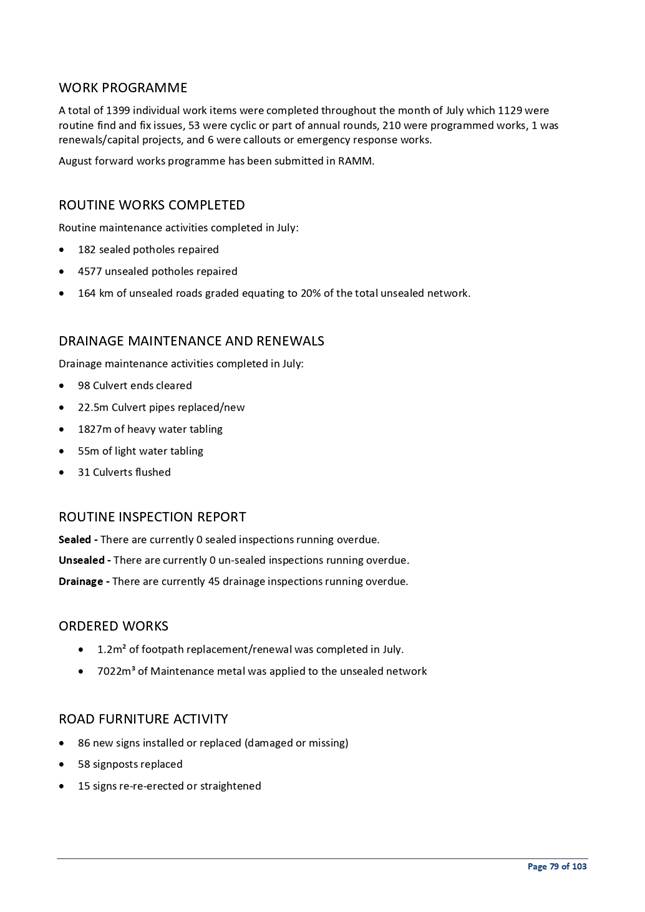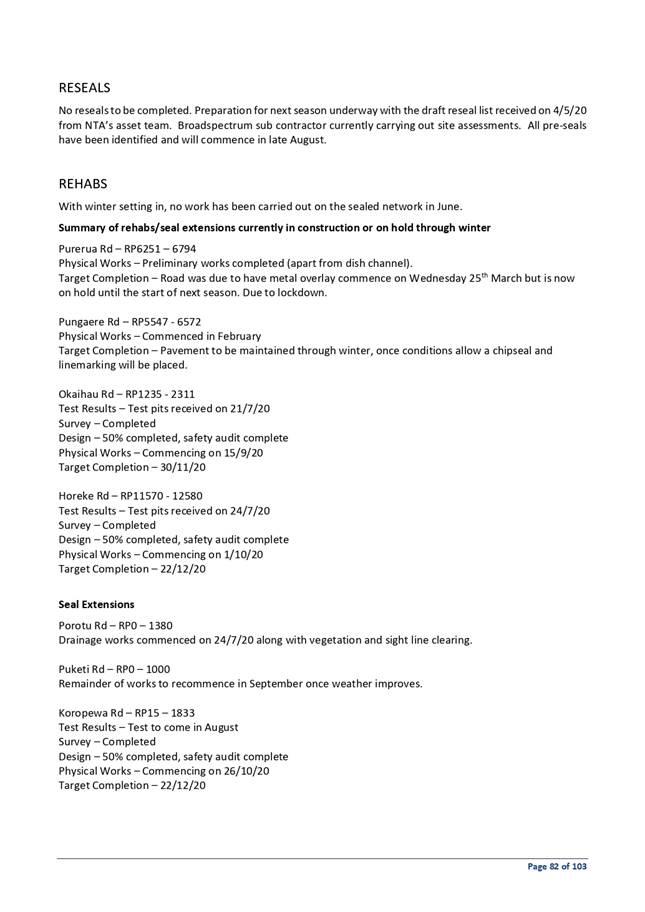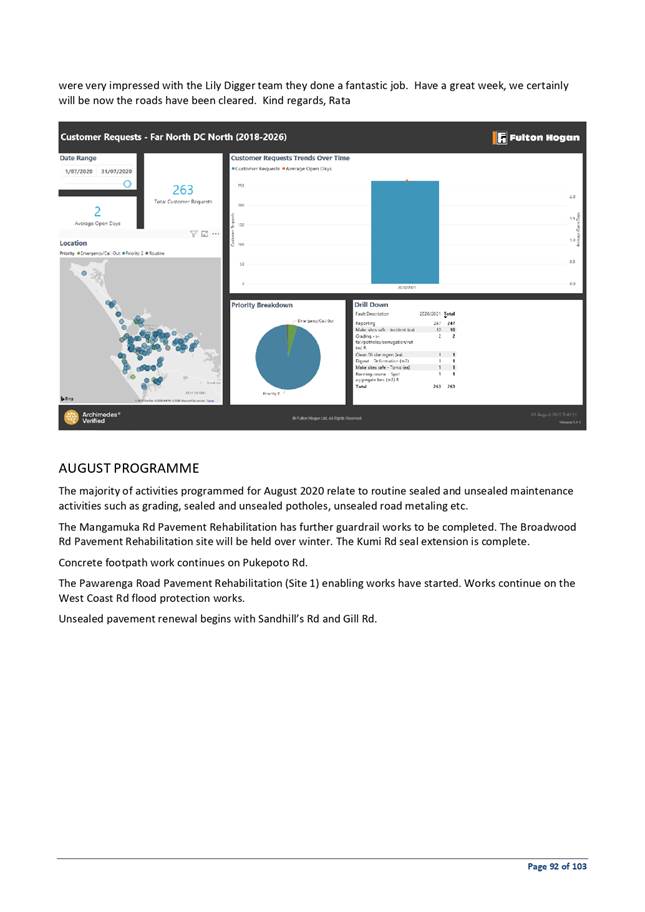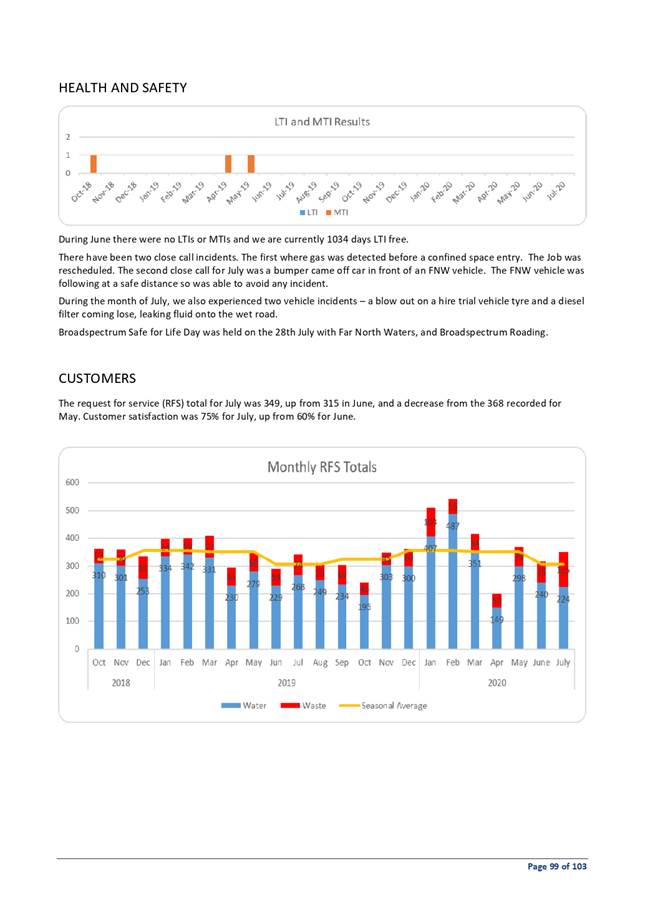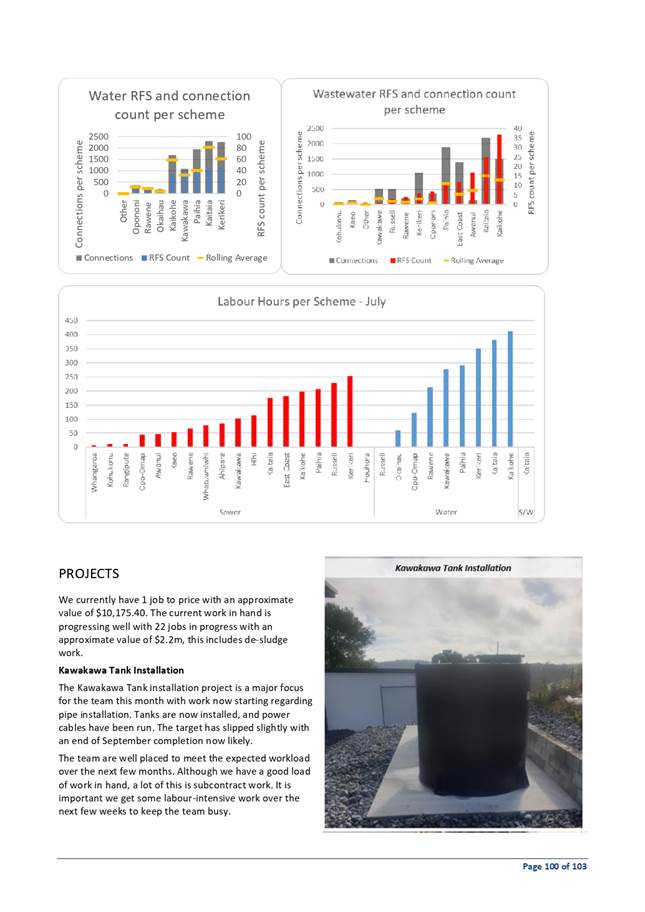
Te
Kaunihera o Tai Tokerau ki te Raki
AGENDA
Infrastructure Committee Meeting
Wednesday, 9 September 2020
|
Time:
|
9.30 am
|
|
Location:
|
Virtually via Microsoft Teams
|
Membership:
Cr Felicity
Foy - Chairperson
Deputy Mayor
Ann Court – Deputy Chairperson
Mayor John
Carter
Cr Dave
Collard
Cr Mate
Radich
Cr Kelly
Stratford
Cr John
Vujcich
Kaikohe-Hokianga
Community Board Chairperson Mike Edmonds
Te Hiku
Community Board Chairperson Adele Gardner
|

|
Authorising Body
|
Mayor/Council
|
|
Status
|
Standing Committee
|
|
COUNCIL COMMITTEE
|
Title
|
Infrastructure Committee Terms
of Reference
|
|
Approval Date
|
7 May 2020
|
|
Responsible Officer
|
Chief Executive
|
Purpose
The purpose of the
Infrastructure Committee (the Committee) is to ensure cost effective, quality
and sustainable infrastructure decisions are made to meet the current and
future needs of Far North communities and that Councils infrastructure assets
are effectively maintained and operated.
The Committee will review the
effectiveness of the following aspects:
·
Affordable core infrastructure to
support healthy and sustainable living;
·
Operational performance including
monitoring and reporting on significant infrastructure projects
·
Delivery of quality infrastructure and
district facilities
·
Financial spend and reprogramming of
capital works
·
Property and other assets
To perform his or her role
effectively, each Committee member must develop and maintain
his or her skills and knowledge,
including an understanding of the Committee’s responsibilities,
Councils’ infrastructure assets such as roading, three waters and district
facilities.
Membership
The Council will determine the
membership of the Infrastructure Committee.
The Infrastructure Committee
will comprise of at least six elected members (one of which will be the
chairperson).
.
|
Mayor
Carter
|
|
Felicity
Foy – Chairperson
|
|
Ann
Court – Deputy Chairperson
|
|
Dave
Collard
|
|
Kelly
Stratford
|
|
John
Vujcich
|
|
Mate
Radich
|
|
Mike
Edmonds
|
|
Adele
Gardner
|
Non-appointed
councillors may attend meetings with speaking rights, but not voting rights.
Quorum
The quorum at a
meeting of the Infrastructure Committee is 5 members.
Frequency of
Meetings
The Infrastructure Committee shall meet every 6 weeks, but
may be cancelled if there is no business.
Power to
Delegate
The Infrastructure
Committee may not delegate any of its responsibilities, duties or powers.
Committees
Responsibilities
The Committees responsibilities
are described below:
Quality
infrastructure and Facilities
·
Assess and provide advice to Council on strategic issues relating
to the provision of Council’s infrastructural activities and district
facilities
·
Review, and recommend to Council, policy and strategies for the
delivery of infrastructural asset services
·
Monitor achievement of outcomes included in the Infrastructure
Strategy and other infrastructure strategies eg District Transport Strategy
·
Ensure that Council protects its investment in its infrastructural
assets in accordance with accepted professional standards
·
Monitor the risks, financial and operational performance of the
Council's infrastructural activities and facilities
·
Monitor major contract performance measures/key result areas
(KRAs)
Significant
Projects – spend, monitoring and reporting
·
Monitor significant projects
·
Approve budget overspend (above
tolerance levels in the CE delegations) and any reprogramming of capex for a
project or programme provided that:
o
The overall budget is met from savings
o
The overall budget for capex is not
exceeded. Where this is not the case, the Committee must either:
§
Recommend to Council that additional
funding is approved (outside the Annual Plan or Long Term Plan process), or
§
Recommend as part of the next round of
Long Term Plan or Annual Plan process that the funding is considered for
inclusion.
·
Approve tenders and contracts provided
they are:
o
Up to $3 million,
o
in accordance with the current
year’s plan, whether that be Annual Plan or Long Term Plan, and
o
deemed low by the Significance and
Engagement Policy
Compliance
·
Ensure that operational functions comply with legislative
requirements and Council policy
·
Ensure that consents associated with Council's infrastructure are
being met and renewals are planned for
Service
levels (non regulatory)
·
Recommend service level changes and new
initiatives to the Long Term and Annual Plan processes.
Relationships
·
Monitoring Council’s relationship
with the Northland Transportation Alliance
o
Receive quarterly performance reports
·
Monitoring Council’s relationship
with the Far North Waters Alliance Partner
Property
·
Recommend to Council the acquisition or
disposal of assets.
·
Approve new leases and lease renewals
(of non-reserve land), in accordance with the current years’ plan,
whether that be Annual Plan or Long Term Plan.
Receive
updates on changes to national and regional policies that impact on Council
provision of infrastructure and where appropriate make recommendation to
Council.
Rules and
Procedures
Council’s
Standing Orders and Code of Conduct apply to all the committee’s
meetings.
Annual
reporting
The Chair of the Committee will
submit a written report to the Chief Executive on an annual basis. The
review will summarise the activities of the Committee and how it has contributed to the Council’s
governance and strategic objectives. The Chief Executive
will place the report on the next available agenda of the governing body.
INFRASTRUCTURE
COMMITTEE - MEMBERS REGISTER OF INTERESTS
|
Name
|
Responsibility (i.e.
Chairperson etc)
|
Declaration of
Interests
|
Nature of Potential
Interest
|
Member's Proposed
Management Plan
|
|
Hon John Carter QSO
|
Board Member of the
Local Government Protection Programme
|
Board Member of the
Local Government Protection Program
|
|
|
|
Carter Family Trust
|
|
|
|
|
Felicity Foy (Chair)
|
Director - Northland
Planning & Development
|
I am the director of a
planning and development consultancy that is based in the Far North and have
two employees.
Property owner of
Commerce Street, Kaitaia
|
|
I will abstain from any
debate and voting on proposed plan change items for the Far North District
Plan.
|
|
|
|
|
I will declare a
conflict of interest with any planning matters that relate to resource
consent processing, and the management of the resource consents planning
team.
|
|
|
|
|
I will not enter into
any contracts with Council for over $25,000 per year. I have previously
contracted to Council to process resource consents as consultant planner.
|
|
Flick Trustee Ltd
|
I am the director of
this company that is the company trustee of Flick Family Trust that owns
properties Seaview Road – Cable Bay, and Allen Bell Drive - Kaitaia.
|
|
|
|
Elbury Holdings Limited
|
This company is
directed by my parents Fiona and Kevin King.
|
This company owns
several dairy and beef farms, and also dwellings on these farms. The Farms
and dwellings are located in the Far North at Kaimaumau, Bird Road/Sandhills
Rd, Wireless Road/ Puckey Road/Bell Road, the Awanui Straight and Allen Bell
Drive.
|
|
|
Foy Farms Partnership
|
Owner and partner in
Foy Farms - a farm on Church Road, Kaingaroa
|
|
|
|
Foy Farms Rentals
|
Owner and rental
manager of Foy Farms Rentals for 7 dwellings on Church Road, Kaingaroa and 2
dwellings on Allen Bell Drive, Kaitaia, and 1 property on North Road,
Kaitaia, one title contains a cell phone tower.
|
|
|
|
King Family Trust
|
This trust owns several
titles/properties at Cable Bay, Seaview Rd/State Highway 10 and Ahipara -
Panorama Lane.
|
These trusts own
properties in the Far North.
|
|
|
Previous employment at
FNDC 2007-16
|
I consider the staff
members at FNDC to be my friends
|
|
|
|
Shareholder of Coastline
Plumbing NZ Limited
|
|
|
|
|
Felicity Foy -
Partner
|
Director of Coastline
Plumbing NZ Limited
|
|
|
|
|
Friends with some FNDC
employees
|
|
|
|
|
Deputy Mayor Ann
Court (Deputy)
|
Waipapa Business
Association
|
Member
|
|
Case by case
|
|
Warren Pattinson
Limited
|
Shareholder
|
Building company. FNDC
is a regulator and enforcer
|
Case by case
|
|
Kerikeri Irrigation
|
Supplies my water
|
|
No
|
|
Top Energy
|
Supplies my power
|
|
No other interest
greater than the publics
|
|
District Licensing
|
N/A
|
N/A
|
N/A
|
|
Top Energy Consumer
Trust
|
Trustee
|
Crossover in regulatory
functions, consenting economic development and contracts such as street
lighting.
|
Declare interest and
abstain from voting.
|
|
Ann Court Trust
|
Private
|
Private
|
N/A
|
|
Waipapa Rotary
|
Honorary member
|
Potential community
funding submitter
|
Declare interest and
abstain from voting.
|
|
Properties on Onekura
Road, Waipapa
|
Owner Shareholder
|
Any proposed FNDC
Capital works or policy change which may have a direct impact (positive/adverse)
|
Declare interest and
abstain from voting.
|
|
Property on Daroux Dr,
Waipapa
|
Financial interest
|
Any proposed FNDC
Capital works or policy change which may have a direct impact (positive/adverse)
|
Declare interest and
abstain from voting.
|
|
Flowers and gifts
|
Ratepayer 'Thankyou'
|
Bias/
Pre-determination?
|
Declare to Governance
|
|
Coffee and food
|
Ratepayers sometimes
'shout' food and beverage
|
Bias or
pre-determination
|
Case by case
|
|
Staff
|
N/A
|
Suggestion of not being
impartial or pre-determined!
|
Be professional, due
diligence, weigh the evidence. Be thorough, thoughtful, considered impartial
and balanced. Be fair.
|
|
Warren Pattinson
|
My husband is a builder
and may do work for Council staff
|
|
Case by case
|
|
Ann Court - Partner
|
Warren Pattinson
Limited
|
Director
|
Building Company. FNDC
is a regulator
|
Remain at arm’s
length
|
|
Air NZ
|
Shareholder
|
None
|
None
|
|
Warren Pattinson
Limited
|
Builder
|
FNDC is the consent
authority, regulator and enforcer.
|
Apply arm’s
length rules
|
|
Property on Onekura
Road, Waipapa
|
Owner
|
Any proposed FNDC
capital work in the vicinity or rural plan change. Maybe a link to policy
development.
|
Would not submit.
Rest on a case by case basis.
|
|
David Collard
|
Snapper Bonanza 2011
Limited
|
45% Shareholder and
Director
|
|
|
|
Trustee of Te Ahu
Charitable Trust
|
Council delegate to
this board
|
|
|
|
Mate Radich
|
No form received
|
|
|
|
|
Kelly Stratford
|
KS Bookkeeping and Administration
|
Business Owner,
provides book keeping, administration and development of environmental
management plans
|
None perceived
|
Step aside from
decisions that arise, that may have conflicts
|
|
Waikare Marae Trustees
|
Trustee
|
Maybe perceived
conflicts
|
Case by case basis
|
|
Bay of Islands College
|
Parent Elected Trustee
|
None perceived
|
If there was a
conflict, I will step aside from decision making
|
|
Karetu School
|
Parent Elected Trustee
|
None perceived
|
If there was a
conflict, I will step aside from decision making
|
|
Māori title land
– Moerewa and Waikare
|
Beneficiary and husband
is a shareholder
|
None perceived
|
If there was a
conflict, I will step aside from decision making
|
|
Sister is employed by
Far North District Council
|
|
|
Will not discuss work/governance
mattes that are confidential
|
|
Gifts - food and
beverages
|
Residents and
ratepayers may ‘shout’ food and beverage
|
Perceived bias or
predetermination
|
Case by case basis
|
|
Kelly Stratford -
Partner
|
Chef and Barista
|
Opua Store
|
None perceived
|
|
|
Māori title land
– Moerewa
|
Shareholder
|
None perceived
|
If there was a conflict
of interest, I would step aside from decision making
|
|
John Vujcich
|
Board Member
|
Pioneer Village
|
Matters relating to
funding and assets
|
Declare interest and
abstain
|
|
Director
|
Waitukupata Forest Ltd
|
Potential for council
activity to directly affect its assets
|
Declare interest and
abstain
|
|
Director
|
Rural Service Solutions
Ltd
|
Matters where council
regulatory function impact of company services
|
Declare interest and
abstain
|
|
Director
|
Kaikohe (Rau Marama)
Community Trust
|
Potential funder
|
Declare interest and
abstain
|
|
Partner
|
MJ & EMJ Vujcich
|
Matters where council
regulatory function impacts on partnership owned assets
|
Declare interest and
abstain
|
|
Member
|
Kaikohe Rotary Club
|
Potential funder, or
impact on Rotary projects
|
Declare interest and
abstain
|
|
Member
|
New Zealand Institute
of Directors
|
Potential provider of
training to Council
|
Declare a Conflict of
Interest
|
|
Member
|
Institute of IT Professionals
|
Unlikely, but possible
provider of services to Council
|
Declare a Conflict of
Interest
|
|
Member
|
Kaikohe Business
Association
|
Possible funding
provider
|
Declare a Conflict of
Interest
|
|
Mike Edmonds
|
Chair
|
Kaikohe Mechanical and
Historic Trust
|
Council Funding
|
Decide at the
time
|
|
Committee member
|
Kaikohe Rugby Football
and Sports Club
|
Council Funding
|
Withdraw and abstain
|
|
Adele
Gardner
|
N/A - FNDC
Honorarium
|
|
|
|
|
The Far
North 20/20, ICT Trust
|
Trustee
|
|
|
|
Te Ahu
Charitable Trust
|
Trustee
|
|
|
|
ST Johns
Kaitaia Branch
|
Trustee/
Committee Member
|
|
|
|
I know many
FNDC staff members as I was an FNDC staff member from 1994-2008.
|
|
|
|
|
Partner
of Adele Gardner
|
N/A as
Retired
|
|
|
|
2 Apologies
and Declarations of Interest
Members need to
stand aside from decision-making when a conflict arises between their role as a
Member of the Committee and any private or other external interest they might
have. This note is provided as a reminder to Members to review the matters on
the agenda and assess and identify where they may have a pecuniary or other
conflict of interest, or where there may be a perception of a conflict of
interest.
If a Member
feels they do have a conflict of interest, they should publicly declare that at
the start of the meeting or of the relevant item of business and refrain from
participating in the discussion or voting on that item. If a Member thinks they
may have a conflict of interest, they can seek advice from the Chief Executive
Officer or the Team Leader Democracy Support (preferably before the meeting).
It is noted
that while members can seek advice the final decision as to whether a conflict
exists rests with the member.
3 Deputation
No requests for deputations were received at the time of the
Agenda going to print.
4 Confirmation
of Previous Minutes
4.1 Confirmation
of Previous Minutes
File
Number: A2935336
Author: Kim
Hammond, Meetings Administrator
Authoriser: Aisha
Huriwai, Team Leader Democracy Services
Purpose of the Report
The minutes of the previous
Infrastructure Committee meeting are attached to allow the Committee to confirm
that the minutes are a true and correct record.
|
Recommendation
That the Infrastructure Committee confirm that the
minutes of the meeting held 12 February 2020.
|
1) Background
Local Government Act 2002 Schedule
7 Section 28 states that a local authority must keep minutes of its
proceedings. The minutes of these proceedings duly entered and
authenticated as prescribed by a local authority are prima facie evidence of
those meetings.
2) Discussion and Options
The
minutes of the meeting are attached. Far North District Council Standing Orders
Section 27.3 states that no discussion shall arise on the substance of the
minutes in any succeeding meeting, except as to their correctness.
Reason
for the recommendation
The reason for the recommendation
is to confirm the minutes are a true and correct record of the previous
meeting.
3) Financial Implications and Budgetary
Provision
There are no financial implications or the need for
budgetary provision as a result of this report.
Attachments
1. 2020-02-12
Infrastructure Committee Unconfirmed Minutes - A2847391 ⇩ 
Compliance schedule:
Full consideration has been given to the provisions of the
Local Government Act 2002 S77 in relation to decision making, in particular:
1. A
Local authority must, in the course of the decision-making process,
a) Seek
to identify all reasonably practicable options for the achievement of the
objective of a decision; and
b) Assess
the options in terms of their advantages and disadvantages; and
c) If
any of the options identified under paragraph (a) involves a significant
decision in relation to land or a body of water, take into account the
relationship of Māori and their culture and traditions with their ancestral
land, water sites, waahi tapu, valued flora and fauna and other taonga.
2. This
section is subject to Section 79 - Compliance with procedures in relation to
decisions.
|
Compliance
requirement
|
Staff
assessment
|
|
State the level of significance
(high or low) of the issue or proposal as determined by the Council’s
Significance and Engagement Policy
|
This is a matter of low significance.
|
|
State the relevant Council
policies (external or internal), legislation, and/or community outcomes (as
stated in the LTP) that relate to this decision.
|
This report complies with the
Local Government Act 2002 Schedule 7 Section 28.
|
|
State whether this issue or
proposal has a District wide relevance and, if not, the ways in which the
appropriate Community Board’s views have been sought.
|
It is the responsibility of each
meeting to confirm their minutes therefore the views of another meeting are
not relevant.
|
|
State the possible implications for Māori
and how Māori have been provided with an opportunity to contribute to
decision making if this decision is significant and relates to land and/or
any body of water.
|
There are no implications on
Māori in confirming minutes from a previous meeting. Any implications on
Māori arising from matters included in meeting minutes should be
considered as part of the relevant report.
|
|
Identify persons likely to be
affected by or have an interest in the matter, and how you have given
consideration to their views or preferences (for example – youth, the
aged and those with disabilities.
|
This report is asking for the
minutes to be confirmed as true and correct record, any interests that affect
other people should be considered as part of the individual reports.
|
|
State the financial implications
and where budgetary provisions have been made to support this decision.
|
There are no financial
implications or the need for budgetary provision arising from this report.
|
|
Chief Financial Officer review.
|
The Chief Financial Officer has
not reviewed this report.
|
|
Infrastructure Committee Meeting Agenda
|
9 September 2020
|
MINUTES OF Far North District
Council
Infrastructure Committee Meeting
HELD AT THE Council Chamber, Memorial
Avenue, Kaikohe
ON Wednesday, 12 February 2020 AT
9.32 am
PRESENT: Cr Felicity Foy, Cr Dave Collard, Cr Mate Radich, Cr Kelly
Stratford, Cr John Vujcich
|
1 Opening
|
|
Chairperson Foy opened the meeting by
reading the purpose of the Local Government Act 2002.
|
2 Apologies
and Declarations of Interest
|
Committee Resolution 2020/1
Moved: Cr
Kelly Stratford
Seconded: Cr
Dave Collard
That the apologies from His Worship the
Mayor who was not able to attend the meeting and Councillor Ann Court who is
attending the Regional Land Transport Committee meeting on behalf of Council,
be received and accepted.
Carried
|
|
3 Deputation
|
|
Ken McLeay representing Riverview School spoke
regarding Item 4.1 Riverview School – Parking and Access Options
Update.
Calvin Thomas - Northland Transport
Alliance Manager, provided an introduction and update to members.
David Webb - Business Manager Water
Northland Broadspectrum, provided an introduction and update to the members
on Far North Waters.
|
|
Attachments tabled at meeting
1 Northland Transport Alliance
Presentation
2 Far North Waters Presentation
|
At 10:15 am, Cr Kelly Stratford left the
meeting. At 10:16 am, Cr Kelly Stratford returned to
the meeting.
At 10:27 am, Cr Dave Collard left the
meeting. At 10:29 am, Cr Dave Collard returned to the
meeting.
4 Reports
|
4.1 Riverview
School - Parking and Access Options Update
Agenda item 3.1 document number A2823938, pages 10 - 33 refers
Sandi Morris – Road Safety and Traffic Planning Engineer
spoke to this report.
|
|
Committee Resolution 2020/2
Moved: Cr
Felicity Foy
Seconded: Cr
John Vujcich
That the Infrastructure Committee:
a) revokes
the following resolution of the Infrastructure Network Committee – 18
July 2019, 7.2 Riverview School Road – Parking and Access Options
“That
the Infrastructure Network Committee approves a central raised median align
the centreline of the road near the drop off bay of Riverview School”.
b) approves
Riverview School and Northland Transport Alliance discussions to amend
operational management requirements at the school gate with minor changes to
signs and markings within existing budgets.
c) note
that Riverview School are undertaking responsible operating practise with
managing children’s behaviour at the school gate and will remind
parents of the schools’ obligations under the Health & Safety at
Work Act 2015.
Carried
|
5 Meeting
Close
The meeting closed at 11.04 am.
The minutes of this meeting will be
confirmed at the Infrastructure Committee meeting to be held on 25 March 2020.
...................................................
CHAIRPERSON
5 Reports
5.1 Three
Waters Programme of Works
File
Number: A2926053
Author: Tanya
Proctor, Team Leader - Infrastructure Programmes
Authoriser: Andy
Finch, General Manager - Infrastructure and Asset Management
Purpose of the Report
To seek approval for a programme of works for water and
waste water capital projects.
Executive Summary
· Staff have previous highlighted that in order to maximise delivery
of the capital work programme there is a need to package work to achieve
operational and procurement efficiencies.
· Council has an existing Water Services Alliance Agreement contract
with Broadspectrum that allows for capital works to be undertaken.
· Councils Water Bylaw requires all works on live water mains to be
carried out by officers or agents of Council.
· A programme of works is a planned and strategic approach to the
water and waste water capital projects.
|
Recommendation
That the Infrastructure Committee approves the
attached programme of works to Far North Waters in accordance with the Water
Services Alliance Agreement for the amount of $2,479,516.00.
|
1) Background
The annual capital works programme comprises of both new and
renewal waters projects. These projects have traditionally been procured
individually which is an inefficient practice. A programme of works will
reduce the number of individual procurements for similar work, reducing project
management time and costs and allowing for quicker delivery of projects.
Clause 3.1.1.3 of the Water Services Alliance Agreement
between Council and Broadspectrum contract with Far North waters reads:
“Capital Works at Council’s absolute
discretion may be allocated to Far North Waters. This would include
reactive renewals, planned renewals, minor and other capital works. The
process for this is outlines within Schedule 5 and Appendix D”. Schedule
5 and Appendix D are attached.
Clause 718.1 of Council’s Water Bylaw reads:
“No person, other than an officer or an agent of Council
shall, without express written authority signed by the Chief Executive, make
any connection with or otherwise interfere with, any part of the water works
system”.
The water main and meter renewals are to be carried out by
Far North Waters is supported by this bylaw. The proposed works are
operational by nature and include upgrades of wastewater pump stations. Scopes
have been received for 15 of the 23 proposed projects.
The value of the proposed programme from FY20/21 is
$2,479,516 and is 20% of the overall $12,019,000 waters budget.
2) Discussion and Options
The proposed value is $2,479,516 and is within the delegated
financial authority of the Infrastructure Committee to approve.
Option 1: Continue to procure individually.
This option does not improve efficiencies but can be
continued. This may reduce the quantum of delivery over the year.
Option 2: Approve a programme of works (preferred
option).
This option will reduce the procurement time and allows the
work to be programmed in by the contractor. A draft programme is
attached.
Reason
for the recommendation
A planned approach utilising existing contracts will reduce
time and cost of staff procuring individually.
3) Financial Implications and Budgetary
Provision
All projects in the programme of works have budgets for
FY20/21 as approved in the Annual Plan.
Attachments
1. Programme of
Works - A2940650 ⇩ 
2. Project Plan
2020-2021 - A2940555 ⇩ 
3. Appendix D of the
Water Services Alliance Agreement - A2940560 ⇩ 
Compliance schedule:
Full consideration has been given to the provisions of the
Local Government Act 2002 S77 in relation to decision making, in particular:
1. A
Local authority must, in the course of the decision-making process,
a) Seek
to identify all reasonably practicable options for the achievement of the
objective of a decision; and
b) Assess
the options in terms of their advantages and disadvantages; and
c) If
any of the options identified under paragraph (a) involves a significant
decision in relation to land or a body of water, take into account the
relationship of Māori and their culture and traditions with their
ancestral land, water sites, waahi tapu, valued flora and fauna and other
taonga.
2. This
section is subject to Section 79 - Compliance with procedures in relation to
decisions.
|
Compliance
requirement
|
Staff
assessment
|
|
State the level of significance
(high or low) of the issue or proposal as determined by the Council’s
Significance and Engagement Policy
|
The significance is low as all
budgets are in the Annual Plan.
|
|
State the relevant Council
policies (external or internal), legislation, and/or community outcomes (as
stated in the LTP) that relate to this decision.
|
The Water Bylaw and Water
Services Alliance Agreement are referred to.
|
|
State whether this issue or
proposal has a District wide relevance and, if not, the ways in which the appropriate
Community Board’s views have been sought.
|
The projects are scheme based and
Community Boards have been engaged through the Annual Plan approval.
|
|
State the possible implications for Māori
and how Māori have been provided with an opportunity to contribute to
decision making if this decision is significant and relates to land and/or
any body of water.
|
Utilising existing operation and
maintenance contractors that are familiar with water and wastewater safety
and protocols will reduce the risk of water contamination or wastewater
spills to land or water bodies.
|
|
Identify persons likely to be
affected by or have an interest in the matter, and how you have given
consideration to their views or preferences (for example – youth, the aged
and those with disabilities.
|
There are not considered to be
any further affected or interested parties.
|
|
State the financial implications
and where budgetary provisions have been made to support this decision.
|
All budgets are approved in
FY20/21.
|
|
Chief Financial Officer review.
|
The Chief Financial Officer has
approved this report,
|
|
Infrastructure Committee Meeting Agenda
|
9 September 2020
|
|
Project Name
|
Budget
|
|
|
|
|
Kawakawa meter replacement
|
$
53,000.00
|
|
Kerikeri meter replacement
|
$
69,000.00
|
|
Okaihau meter replacement
|
$
16,000.00
|
|
Opononi meter replacement
|
$
14,000.00
|
|
Paihia meter replacement
|
$
69,000.00
|
|
Kaikohe meter replacement
|
$
63,000.00
|
|
Kaitaia meter replacement
|
$
69,000.00
|
|
Homestead Road replacement
|
$
57,000.00
|
|
Awanui improvements
|
$
300,000.00
|
|
Paihia mains
|
$
86,000.00
|
|
Opononi Waiotemarama source upgrade
|
$
107,000.00
|
|
Kaitaia WTP relocate pumps and controls
|
$
86,000.00
|
|
Kaitaia Te Maire Res line
|
$
101,516.00
|
|
Waipapa Water Mains
|
$
150,000.00
|
|
Total Water
|
$
1,240,516.00
|
|
|
|
|
Paihia PS22 Sullivans Rd
|
$
110,000.00
|
|
Ahipara PS6 Upgrade
|
$
101,000.00
|
|
East Coast Bush Point Rd PS upgrade
|
$
102,000.00
|
|
East Coast PS11 Upgrade
|
$
102,000.00
|
|
East Coast PS11 Odour Control
|
$
84,000.00
|
|
Kaitaia Jamieson Rd PS Upgrade
|
$
106,000.00
|
|
Paihia PS11 odour issues
|
$
115,000.00
|
|
Rawene new reticulation
|
$
115,000.00
|
|
East Coast WWTP wavebands
|
$
115,000.00
|
|
Kaitaia Ahipara Rd Upgrade
|
$
110,000.00
|
|
Russell WWTP UV
|
$
69,000.00
|
|
H&S WWTP Improvements
|
$
110,000.00
|
|
Total Wastewater
|
$
1,239,000.00
|
|
|
|
|
Total Water and Wastewater
|
$
2,479,516.00
|
|
Infrastructure
Committee Meeting Agenda
|
9 September 2020
|



Appendix D Capital
Works
Overview
Capital works (works beyond
repairs that would be undertaken within the scope of the Operations and
Maintenance), while not part of the Alliance contract, may be agreed too during
the term of the contract. These would include:
· Renewals - Reactive
· Renewals - Planned
· Capital Work - Minor
· Capital Work –
Other (Significant)
The actual capital spent in 2016/17 was:
· about
$800,000 on reactive renewals
· $250,000
for water supply minor capital
$250,000 for wastewater
minor capital
While all
capital works are discretionary, it is the intention that the Alliance proposes
an annual capital programme and indicative three year programme in line with
the LTP. In
addition, the Alliance can identify new work projects on the basis of a
reduction in O&M costs, with an appropriate return period, or significant
reduction in risk to Council. The delivery of the
annual programme would be an alliance KPI.
A prioritisation
framework would be developed for each of the three waters. Final approval of
the delivery programme will be a Council decision.
Council at its
sole discretion will make a decision as to whether capital works are undertaken
by the Alliance at an agreed price, by the Alliance after a competitive tender
process, or by others. As a minimum Council will retain the right to market
test a proportion of the work for which the Alliance could bid i.e. potentially
up to 20% by programme value annually.
The Alliance may be
allocated separate fixed annual sums for water, wastewater and urban stormwater
renewals each year but this work is not guaranteed.
The PAP should set up a
capital projects group that would be available to deal with reactive renewals
and incidents without removing staff from the operations and maintenance teams.
Renewals
For
reactive renewals, Council may make a decision to award the Alliance these
works if there are Health and Safety and/or Consent breach risks if the works
are not undertaken immediately.
For planned minor renewals investigation, design and
documentation/scheduling of capital works undertaken by the PAP will be
compensated as follows:
a. Actual
costs will be reimbursed on the same basis as for Operations and Maintenance
set out in Schedule 5.
b. Profit
and off-site overheads associated with this service are included in the
compensation described in Schedule 5 and only payable if an AA is entered into.
Where the PAP procures, manages and supervises
subcontracts for planned renewals the PAP will be compensated as follows:
a. Full reimbursement
of Actual and reasonable payments made to the subcontractor for the Work and
Actual costs for procurement, management and supervision of the subcontract
will be reimbursed on the same basis as for Operations and Maintenance set out
in Schedule 5.
b. Profit and off-site
overheads associated with this service are included in the compensation
described in Schedule 5, and therefore only payable if an AA is entered into.
Capital Works
Where Council in its absolute discretion allocates to the
PAP capital works and new services, the design and construction will be priced
and compensated for on the basis of an agreed schedule of rates or lump sum
price for the work.
The process will be for a
Project Target Cost (PTC) to be agreed between the Alliance and the Clients
Project Budget Holder.
The PTC covered the
following items of work
· Preparation of concept
design
· Preparation of
detailed design and specifications
· Obtaining resource /
building consents
· Construction and
installation
· Construction
monitoring
· Commissioning
· Preparation of
as-built information
· Preparation of
Operating and Maintenance manuals
The PTC comprised the actual
costs, including on-site overheads plus off site overheads and profit at agreed
percentages. The following categories of capital work will be identified:
· Work undertaken by
staff within the PAP
· Work undertaken by Sub
– Contractors
· High value capital
items i.e. generators – will identify the agreed mark-up / margin
FNDC will also be asking how
the tenderer can provide assurances that the projects are being run as
efficiently as possible. This information will be used to assess
PTC’s throughout the contract term.
The existing contractual
arrangements allow for the profit on any project (excluding high value capital
items) to be adjusted in relation to performance against Key Performance
Indicators as described below.
Performance
Performance on each project
will be reviewed jointly by the FNDC Project Manager and the Alliance Manager
within 3 months of the Practical Completion of the Project. Overall Performance
will be reviewed every 6 months and will be measured on the capital projects
closed out in the 6 month period. A total of 13 Key Performance Indicators are
used as shown in the table below. The key result areas and KPIs that
pertain to the Performance Indicators contained in Appendix 5, need to be
agreed and finalised by both parties in the first three months of the IAA in
order to monitor and report the performance of the Alliance.
Key Performance Indicators for Capital
Work:
|
No
|
Key Performance Indicator
|
REF
|
Method of measurement
|
Measured Performance
|
Result
|
Weight
|
Score
|
|
P1
|
Project Cost
|
P1.1
|
Ratio of
Actual outturn cost to agreed Target cost
|
<1.0
|
10
|
2
|
|
|
1 to 1.1
|
5
|
|
|
>1.1
|
0
|
|
|
P1.2
|
Project
variations raised and requested prior to implementing
|
Yes
|
5
|
|
|
No
|
0
|
|
|
P2
|
Program
|
P2.1
|
Accuracy
of agreed project duration after VO compared to VA forecast duration
|
Within
forecast
|
2
|
1.5
|
|
|
Outside
forecast
|
0
|
|
|
P2.2
|
Program issued within 2 weeks of VO receipt
|
Yes
|
3
|
|
|
No
|
0
|
|
|
P2.3
|
Project
completed in accordance with agreed program
|
Yes
|
5
|
|
|
No
|
0
|
|
|
P3
|
H&S
|
P3.1
|
Project
SSSP provided & reviewed prior H&S to construction start
|
Yes
|
5
|
|
|
|
No
|
0
|
2
|
|
|
P3.2
|
Projects
Site audit average score >90%
|
Yes
|
3
|
|
|
|
P3.3
|
Accident
or dangerous occurrence on site
|
No
|
0
|
|
|
|
P4
|
Quality
|
P4.1
|
Project
outcomes met in accordance with agreed scope
|
Fully
|
5
|
1
|
|
|
Partially
|
2
|
|
|
Inadequate
|
0
|
|
|
P4.2
|
Project
management, reporting, communication ect
|
Excellent
|
2
|
|
|
Acceptable
|
1
|
|
|
Poor
|
0
|
|
|
P4.3
|
Workmanship and specification
|
Excellent
|
3
|
|
|
Acceptable
|
2
|
|
|
Poor
|
0
|
|
|
P5
|
Project
Handover
|
P5.1
|
Formal project hand overs, signed off within
3 months from construction completion
|
<3
months
|
10
|
1.5
|
|
|
<4
months
|
5
|
|
|
>4
months
|
0
|
|
|
P6
|
Project
Review
|
P6.1
|
Formal projects reviews signed off within 3
months from construction completion
|
<3
months
|
10
|
1
|
|
|
<4
months
|
5
|
|
|
>4
months
|
0
|
|
|
|
|
|
|
|
|
Total
score
|
|
Performance on each capital project is
evaluated separately. A weighted numerical system is used to generate an
overall performance
score. The margins for each capital project completed in a period are adjusted
on the basis of the performance score achieved for the project as follows:
|
Performance score
|
Adjustment of margin
|
|
0
to 40
|
-100%
|
|
41
to 50
|
-50%
|
|
51
to 64
|
-25%
|
|
65
to 90
|
0
|
|
>91
|
+10%
|
5.2 Otaua
Bridge N28 Replacement - Increase in Project Value
File
Number: A2938231
Author: Glenn
Rainham, Manager - Infrastructure Operations
Authoriser: Andy
Finch, General Manager - Infrastructure and Asset Management
Purpose of the Report
To seek approval from the Infrastructure Committee to
increase the contract value of Contract 7/18/200 Otaua Road Bridge from $225,378.81
to $1,030,471.00, giving a revised overall project cost of $1,223,971.61.
Executive Summary
· Council approved the award of Contract 7/18/200 Otaua Road Bridge to
United Civil Construction on 3 March 2020.
· The original value of the contract was $805,092.88 within an overall
project budget of $998,592.88.
· The project has received two contract variations; the first relating
to the impact of COVID-19 and the second due to unforeseen ground conditions.
· The total cost of these has been assessed as $225,378.81.
· Approval is now required to increase both the contract sum and
project budget by this amount.
· This decision falls within the delegation of the Infrastructure
Committee.
|
Recommendation
That the Infrastructure Committee:
a) approves
additional capital funding of $225,378.81 plus GST for the Otaua Bridge
Replacement Project
b) approves
an increase in the contract value of Contract 7/18/200 Otaua Road Bridge from
$805,092.88 to $1,030,471.00
c) notes
that as a result of items a and b, the total project cost increases from
$998,592.88 to $1,223,971.61.
|
1) Background
During the course of annual bridge inspections, the Otaua
Bridge N28 was found to be failing and unable to continue bearing the load of
heavy vehicle movements.
The bridge was put under a weight restriction due to failing
structural members that resulted in a detour route for heavy vehicles exceeding
the weight restriction to Ninihi Road an unsealed road that runs past several
residencies, that caused a dust nuisance for the residents
The contract for bridge replacement was awarded to United
Civil Construction Ltd following Council approval on 3rd March 2020 for the sum
of $805,092.88. This formed part of the total approved project cost of
$998,592.88
2) Discussion and Options
Following
the award of Contract 7/18/200 Otaua Road Bridge. The contractor has encountered
unforeseen circumstances outside of their control.
COVID-19
On 23 March the
New Zealand Government announced that, effective from 11:59pm Wednesday 25
March that New Zealand would move into alert level 4. This required all
non-essential work to stop and for non-essential staff to remain at home.
The alert level
was reduced to level 3 on 27 April and then to Level 2 on 13 May 2020.
The result of
these restriction has seen the contractor incur costs that they are now
entitled to claim from the principle under the 3910 Contract framework.
On 27 May 2020,
United Civil claimed a COVID-19 cost amounting to $104,721.56.
This variation
is still under negotiation with the Contractor and the cost at this stage is an
estimate.
Unforeseen
Ground Conditions
As part of the original design the design consultant had
undertaken a geotechnical investigation. However, this did not
pick up the construction material that sat behind the existing abutment walls
and formed the bridge approach and the material that sat under the existing
abutment retaining wall. This was only discovered when the old bridge and
existing abutments were removed.
The assumption was made during the design
that the existing material would be a reasonable existing soil that would be
able to sustain and transfer the live load and that a standard gabion basket retaining
structure would be sufficient. This proposed structure was a design and build
item in the contract.
On removal of the existing bridge and
abutments it was found the material was actually made up of rubble not capable
supporting itself and the lateral loads that would arise and that the proposed
gabion retaining structure would not be sufficient to retain this material and
the loading generated. In addition the ground the gabions were to be located on
was also deemed insufficient to construct on.
Alternative designs where then investigated
that included removal of unsuitable material, tie backs and micro piles. The
most cost effective was redi rock retaining structure with micro piles that
allowed ease of construction and the required retaining capability.
The cost
difference of the alternative design is $120,657.25 which has been assessed and
agreed by the Engineer.
Reason
for the recommendation
To address contract variations associated with COVID-19
response and unforeseen ground conditions.
3) Financial Implications and Budgetary
Provision
Additional Capex funding of $225,378.81 which will be a
district wide rates increase.
Attachments
1. Otaua Bridge
Increase of project value - A2938246 ⇩ 
Compliance schedule:
Full consideration has been given to the provisions of the
Local Government Act 2002 S77 in relation to decision making, in particular:
1. A
Local authority must, in the course of the decision-making process,
a) Seek
to identify all reasonably practicable options for the achievement of the
objective of a decision; and
b) Assess
the options in terms of their advantages and disadvantages; and
c) If
any of the options identified under paragraph (a) involves a significant
decision in relation to land or a body of water, take into account the
relationship of Māori and their culture and traditions with their
ancestral land, water sites, waahi tapu, valued flora and fauna and other
taonga.
2. This
section is subject to Section 79 - Compliance with procedures in relation to
decisions.
|
Compliance
requirement
|
Staff
assessment
|
|
State the level of significance
(high or low) of the issue or proposal as determined by the Council’s
Significance and Engagement Policy
|
Low.
|
|
State the relevant Council policies
(external or internal), legislation, and/or community outcomes (as stated in
the LTP) that relate to this decision.
|
N/A.
|
|
State whether this issue or
proposal has a District wide relevance and, if not, the ways in which the
appropriate Community Board’s views have been sought.
|
Local relevance only. As this is
an existing council asset, it does not require significant community board
input.
|
|
State the possible implications for Māori
and how Māori have been provided with an opportunity to contribute to
decision making if this decision is significant and relates to land and/or
any body of water.
|
As this is an existing council
asset, it does not require significant Iwi input.
|
|
Identify persons likely to be
affected by or have an interest in the matter, and how you have given
consideration to their views or preferences (for example – youth, the
aged and those with disabilities.
|
N/A.
|
|
State the financial implications
and where budgetary provisions have been made to support this decision.
|
As detailed in the report.
|
|
Chief Financial Officer review.
|
The Chief Financial Officer has
reviewed this report.
|
|
Infrastructure Committee Meeting Agenda
|
9 September 2020
|
Meeting: Infrastructure
Committee 09 September 2020
Name of item: Otaua Bridge N28 Replacement – Increase of Project
Value
Author: Zander
Cutang – Renewals Project Manager
Date of
report: 04
August 2020
Purpose
of the report
To seek
Council approval to increase the value of Contract 7/18/200 Otaua Road Bridge.
Executive
summary
Contract 7/18/200 Otaua Road Bridge
was awarded to United Civil Construction Ltd for the sum of $805,092.88
(excluding GST) following Council approval on 3rd March 2020, being
part of the total approved project cost of $998,592.88
The project has encountered
unforeseen cost due to
· COVID-19
pandemic
· Unsuitable
ground conditions.
The total contract value has now
increased by $225,378.81(excluding GST) to $1,223,971.69 (excluding GST).
Recommendation
That the Infrastructure
Committee:
a) Approve
additional funding of $225,378.81 plus GST above the
original total Project Cost
b) Approves the increase in contract value from $805,092.88 to
$1,030,471.00
c) Notes that as a result of items a and b, the total project cost
increases from $998,592.88 to $1,223,971.61
1) Background
During the
course of annual bridge inspections, the Otaua Bridge N28 was found to be
failing and unable to continue bearing the load of heavy vehicle movements.
The bridge
was put under a weight restriction due to failing structural members that
resulted in a detour route for heavy vehicles exceeding the weight restriction
to Ninihi Road an unsealed road that runs past several residencies, that caused
a dust nuisance for the residents
The contract
for bridge replacement was awarded to United Civil Construction Ltd following
Council approval on 3rd March 2020 for the sum of $805,092.88. This formed part
of the total approved project cost of $998,592.88
2) Discussion and
options
Following
the award of Contract 7/18/200 Otaua Road Bridge. The contractor has encountered
unforeseen circumstances outside of their control.
COVID-19
On 23
March the New Zealand Government announced that, effective from 11:59pm
Wednesday 25 March that New Zealand would move into alert level 4. This
required all non-essential work to stop and for non-essential staff to remain
at home.
The
alert level was reduced to level 3 on 27 April and then to Level 2 on 13 May
2020.
The
result of these restriction has seen the contractor incur costs that they are
now entitled to claim from the principle under the 3910 Contract framework.
On 27
May 2020, United Civil claimed a COVID-19 cost amounting to $104,721.56.
This
variation is still under negotiation with the Contractor and the cost at this
stage is an estimate.
Unforeseen
Ground Conditions
As part of
the original design the design consultant had undertaken a geotechnical
investigation. However, this did not pick up the construction
material that sat behind the existing abutment walls and formed the bridge
approach and the material that sat under the existing abutment retaining wall.
This was only discovered when the old bridge and existing abutments were
removed.
The assumption was made during the design that the existing material
would be a reasonable existing soil that would be able to sustain and transfer
the live load and that a standard gabion basket retaining structure would be
sufficient. This proposed structure was a design and build item in the
contract.
On removal of the existing bridge and abutments it was found the
material was actually made up of rubble not capable supporting itself and the
lateral loads that would arise and that the proposed gabion retaining structure
would not be sufficient to retain this material and the loading generated. In
addition the ground the gabions were to be located on was also deemed
insufficient to construct on.
Alternative designs where then investigated that included removal of
unsuitable material, tie backs and micro piles. The most cost effective was
redi rock retaining structure with micro piles that allowed ease of
construction and the required retaining capability.
The
cost difference of the alternative design is $120,657.25 which has been
assessed and agreed by the Engineer.
Reason
for the recommendation
The submitted variation cost
from the contractor has been a significant increase on the total project cost
due to these unforeseen circumstances.
The alternative design and
its estimated price have been reviewed and is deemed reasonable and fit for
purpose.
3) Financial
implications and budgetary provision
The bridge contract was awarded on 3rd
March 2020 after Council approval. At that stage the details of costs were as
follows:
|
Total Tendered
Project Cost
|
|
Contract value (physical works) (including
$46,000 Contingency)
|
$805,092.88
|
|
Beam construction
|
$110,000.00
|
|
Consultant documentation and MSQA
|
$46,000.00
|
|
FNDC – NTA management
|
$37,500.00
|
|
Total Project Cost
|
$998,592.88
|
Variation costs from the Covid 19 delays and
unsuitable ground condition claim:
|
Variation
description
|
Amount
|
|
COVID-19 claim
|
$ 104,721.56
|
|
Update to the design of the retaining wall
|
$ 120,657.25
|
|
Total
|
$225,378.81
|
With the
above additional cost, we are expecting a total project cost to be
$1,223,971.69. A cost increase of $225,378.81.
|
Updated Total Project Cost
|
|
Contract value (physical works) (including
$46,000 Contingency)
|
$1,030,471.69
|
|
Beam construction
|
$110,000.00
|
|
Consultant documentation and MSQA
|
$46,000.00
|
|
FNDC – NTA management
|
$37,500.00
|
|
Total Project Cost
|
$1,223,971.69
|
The project
is funded from the Low-Cost Low risk work category and it is proposed to use
this year’s funding from the same work category to make up for the
shortfall.
The Low Cost
Low Risk funding being utilised to cover the increase in cost had not been allocated
to a specific project but was intended to cover future designs. This will not
have any significant impact to the current year’s programme.
Approval
from NZTA has been attained for the cost increase as well as maintaining the
project under Low Cost Low Risk despite the costs exceeding the $1m threshold.
4) Report Approval
Approved by 
Greg
Monteith – Capital and Procurement Manager
14th
August 2020
Compliance
schedule:
Full consideration has been given
to the provisions of the Local Government Act 2002 S77 in relation to decision
making, in particular:
1. A
Local authority must, in the course of the decision-making process,
a) Seek
to identify all reasonably practicable options for the achievement of the
objective of a decision; and
b) Assess
the options in terms of their advantages and disadvantages; and
c) If
any of the options identified under paragraph (a) involves a significant
decision in relation to land or a body of water, take into account the
relationship of Māori and their culture and traditions with their
ancestral land, water sites, waahi tapu, valued flora and fauna and other
taonga.
2. This
section is subject to Section 79 - Compliance with procedures in relation to
decisions.
|
Compliance
requirement
|
Staff assessment
|
|
State
the level of significance (high or low) of the issue or proposal as
determined by the Council’s
Significance and Engagement Policy
|
a)
High Level.
Inability
to use this bridge for HCV impacts both the Forestry industry, and residents
in terms of dust nuisance.
|
|
State
the relevant Council policies (external or internal), legislation, and/or
community outcomes (as stated in the LTP) that relate to this decision.
|
|
|
State
whether this issue or proposal has a District wide relevance and, if not, the
ways in which the appropriate Community Board’s views have been sought.
|
b)
Local relevance only. As this is an
existing council asset, it does not require significant community board
input.
|
|
State the possible implications for
Māori and how Māori have been provided with an opportunity to
contribute to decision making if this decision is significant and relates to
land and/or any body of water.
|
c)
As this is an existing council asset,
it does not require significant Iwi input, beyond appeasing local Iwi
residents.
|
|
Identify
persons likely to be affected by or have an interest in the matter, and how
you have given consideration to their views or preferences.
|
At the
time of undertaking works we will advise residents and stakeholders –
but there will be no other consultation undertaken.
|
|
State
the financial implications and where budgetary provisions have been made to
support this decision.
|
d)
While talking to forestry companies,
and local residents about dust issues this bridge was raised, and all
affected parties are keen for works to proceed and finish this year.
|
|
Chief
Financial Officer review.
|
Submit
to CFO for signoff using the Objective review function.
|
5.3 NTA
Benefits Assessment
File
Number: A2940302
Author: Glenn
Rainham, Manager - Infrastructure Operations
Authoriser: Andy
Finch, General Manager - Infrastructure and Asset Management
Purpose of the Report
The purpose of this paper is to provide
Elected Members with a summary of benefits identified and assessed as being
achieved to date, through the formation and operation of the Northland
Transportation Alliance (NTA).
Executive Summary
The completed assessment of benefits confirms the formation of the
NTA has produced significant tangible and non-tangible regional benefits to
date, with an estimated circa $10M in cumulative savings being reinvested in
transportation activities across the three Northland districts in the four-year
period from 1st July 2016 to 30th June 2020.
|
Recommendation
That the Infrastructure Committee:
a) receive
the report from the Northland Transportation Alliance
b) note
the contents of the report detailing the assessment of benefits achieved
since formation of the Northland
Transportation Alliance compared with benefit projections contained within
the “Northland Transport Collaboration
Opportunities” Business Case of 2016.
|
1) Background
Commentary is provided within the attached report from the
NTA.
2) Discussion and Options
Commentary is provided within the attached report from the
NTA.
Reason
for the recommendation
Information only report to provide visibility to the
Infrastructure Committee.
3) Financial Implications and Budgetary
Provision
There are no financial implications. Information only
report.
Attachments
1. Attachment 1 -
NTA Benefits Assessment - A2940303 ⇩ 
Compliance schedule:
Full consideration has been given to the provisions of the
Local Government Act 2002 S77 in relation to decision making, in particular:
1. A
Local authority must, in the course of the decision-making process,
a) Seek
to identify all reasonably practicable options for the achievement of the
objective of a decision; and
b) Assess
the options in terms of their advantages and disadvantages; and
c) If
any of the options identified under paragraph (a) involves a significant
decision in relation to land or a body of water, take into account the
relationship of Māori and their culture and traditions with their
ancestral land, water sites, waahi tapu, valued flora and fauna and other
taonga.
2. This
section is subject to Section 79 - Compliance with procedures in relation to
decisions.
|
Compliance
requirement
|
Staff
assessment
|
|
State the level of significance
(high or low) of the issue or proposal as determined by the Council’s
Significance and Engagement Policy
|
This report is of high
significance as there is a lot of public interest with the establishment of
the NTA – both to service delivary and financial savings.
|
|
State the relevant Council
policies (external or internal), legislation, and/or community outcomes (as
stated in the LTP) that relate to this decision.
|
Type
here
|
|
State whether this issue or
proposal has a District wide relevance and, if not, the ways in which the
appropriate Community Board’s views have been sought.
|
This report is of district wide
signifigance.
|
|
State the possible implications for Māori
and how Māori have been provided with an opportunity to contribute to
decision making if this decision is significant and relates to land and/or
any body of water.
|
Type
here
|
|
Identify persons likely to be
affected by or have an interest in the matter, and how you have given
consideration to their views or preferences (for example – youth, the
aged and those with disabilities.
|
Type
here
|
|
State the financial implications
and where budgetary provisions have been made to support this decision.
|
Type
here
|
|
Chief Financial Officer review.
|
The Chief Financial Officer has
reviewed this report.
|
|
Infrastructure Committee Meeting Agenda
|
9 September 2020
|
Meeting: Infrastructure
Committee 09 September 2020
Name of item: NTA Benefits
Assessment
Author: Calvin
Thomas – NTA Manager
Date of
report: 18
August 2020
1 Purpose
The purpose of this paper is to provide
Elected Members with a summary of benefits identified and assessed as being
achieved to date through the formation and operation of the Northland
Transportation Alliance (NTA), noting that Northland Regional Council were not
included within the original Business Case and are therefore excluded from this
assessment.
This assessment was completed in February
2020 however, as a result of COVID-19 lockdowns and disruptions, presentation
to FNDC Infrastructure Committee has been delayed.
2 Background
The primary deliverable
benefits identified within the “Northland Transport Collaboration
Opportunities” Business case of 2016 were:
· More
engaged and capable work force delivering superior asset management
· Improved
transport/customer outcomes, enabling investment and social opportunities
· Improved
Regional strategy, planning & procurement
· Transport
infrastructure is more affordable
Aligning with the
intent outlined within the Business Case, the assessed monetary benefits have
resulted in the ability to improve and maximize the value of spend on the
respective transport networks and do not equate to savings or reduction of
overall transport budgets.
For the purposes of the
benefits assessment exercise, and aligning with the original business case:
· Benefit
analysis relates to the activities of the three district councils only.
· The
annual operating costs of the Shared Services Business Unit (SSBU) have been
accounted for as an additional cost, negatively impacting on benefit
achievement. (Note – does not include any additional “support
services costs” provided by existing departments of individual Councils)
· Values
of Savings and Costs quoted are “Total Costs” being the combination
of Council Local Share and NZTA subsidy.
3 Discussion
Summary
The completed assessment of benefits
confirms the formation of the NTA has produced significant tangible and
non-tangible Regional benefits to date, with an estimated circa $10M in
cumulative savings being reinvested in Transportation activities across the
three Northland districts in the four-year period from 1st July 2016 to 30th
June 2020.
When compared with the 2019/20
projections contained within the Business Case, the calculated achieved
benefits are approximately:
· Double the
“All TLA’s Best Estimate (conservative)”.
· Equal to the
“All TLA’s Optimistic Case”.

Analysis of these savings are further
broken down within this paper to demonstrate the respective benefit achievement
of standalone initiatives and the renewed Maintenance Contracts. The total
summary by council is provided in Table 1.

Table 1: Summarised cumulative benefits (1st
July 2016 to 30th June 2020)
The assessment also confirms the
realisation of several “non-tangible” benefits which are referenced
within this paper.
The analysis has determined that the
formation of the NTA has resulted in the achievement of significant and
quantifiable monetary benefit at a regional level, noting that at present this
is primarily driven by:
1. Savings
associated with the ownership transfer to NZTA of Mangakahia Road.
2. Changes
in the calculated Maintenance Contract costs calculated at $/km.
3. Annual
operational costs introduced with the establishment of the SSBU.
4. Developing
area of savings through supplier & consultant discounting for regional
project engagement (5-10% regional discounts being realised on common
activities, e.g. footpath condition surveys, high speed data surveys, software
licensing etc.) when awarded as a single contract across the Region.
As each of the first three items above
are significant in value, the impact of a negative outcome in any of these for
an individual Council is significant, and is summarised as follows:
· FNDC
o Strong benefit realisation from
combination of SSBU formation costs and non-Maintenance contract activity
savings negatively offset by Maintenance contract cost increase resulting
in overall cumulative cost increase.
o Maintenance cost increase is
primarily the result of the need to introduce a clearly defined, regionally
consistent, higher level of service delivery expectations through the new
inspection led, performance-based contract model, with clarified work
specifications and certainty in increased levels of service.
· KDC
o Negative benefit realisation
from combination of SSBU formation costs and non-Maintenance contract
activities positively offset by significant Maintenance contract
savings resulting in overall cumulative benefit realisation.
· WDC
o Significant financial benefit
realisation across all areas.
Now the NTA is fully established and
historic vacancies have been filled it is planned for further Regional
initiatives to be initiated, the majority of which are expected to return
on-going year-on-year benefits for all three Northland District Councils.
DETAILED
ANALYSIS OF BENEFIT OPPORTUNITY AREAS
A. MORE
ENGAGED AND CAPABLE WORK FORCE DELIVERING SUPERIOR ASSET MANAGEMENT
A.1. Development of engaged and capable work force
In early 2019 the NTA began the
transition away from traditional roading department structures to a new
functional based structure supporting the delivery of consistent transportation
services to Northland. The structure is designed to support development opportunities
for existing staff and ensures specialist technical skills are utilised across
the entire Northland region.
Time sheet analysis (Table 2) of the
first six months of the 2019/20 year show an average of 10% of total NTA staff
time staff time is now being spent working on non-home council activities, with
KDC and FNDC primarily benefiting through the utilisation of key WDC employed
staff.

Table 2: Cross council TOTAL resource allocation
summary (1st July 2019 to 31st December 2019)
Further analysis has been completed on
the staff time allocation information for period of 1st July 2019 to 31st
December 2019 to better understand the spread of operational resource time,
i.e. with Tier 2 operational management time removed (Table 3).
This exercise has been completed to
enable the provision of a true reflection of effort by operational staff and
removes the “cross council charging anomaly” that results from the
Capital Works and Procurement Manager (Greg Monteith) being employed by WDC but
assigned as the key relationship manager for KDC. (Note – this Tier 2
role was originally intended to have KDC as the employing council)

Table 3: Cross council OPERATIONAL resource allocation
summary (1st July 2019 to 31st December 2019)
Removal of Tier 2 hours - Analysis
Findings:
· At
an operational level, FNDC is presently utilising the greatest percentage and
total hours of other council operational resources to complete its works
program.
· Both
KDC and WDC allocate more of their own operational resources to other councils
than they utilise in return.
· As
expected, each of the Tier 2 Managers are spending a greater proportion of
their time working for their assigned “relationship” council than
the others.
· The
reduced level of time booked to other Councils by the Strategy and Planning
Manager is reflective of the historic vacancy of the WDC Asset Management Lead
position, resulting in Jeff working at a more operational level than desired
for the past 12 months. In the interim the regional support of Asset Management
and Strategy has largely been covered by consultant resources, noting that with
commencement of the newly recruited WDC Asset Management Lead on Monday 2nd
March 2020 it is anticipated that Jeff Devine will fully transition into the
more regionally focused role.
·
A.2. Recruitment (* section updated to
reflect status as at August 2020)
At the time of implementing the new
structure (March 2019) 19 of the total 64 identified NTA positions were vacant.
Throughout 2019 and early 2020 significant recruitment activities were
undertaken, with all the originally identified roles now filled.
A key element contributing to the recruitment success was
the decision for the NTA to directly engage a dedicated (0.5 FTE) P&C
resource for a period of 8 months to coordinate all recruitment related
activities. This provided for improved candidate care (minimised risk of losing
good candidates) and a more professional, coordinated and timely process for
advertising, shortlisting and interviewing.
Recruitment completed since March 2019 included:
· 26 Individual
roles filled made up of:
o 19
Original Vacancies
o 4
Internal Promotions of existing staff into leadership roles
o 3
Resignation replacements (made up of 2 existing staff and 1 newly recruited)
· Two
new vacancies, both presently being recruited, remain resulting from:
o 1
newly created role (NRC Cadet)
o 1
recent resignation (FNDC RAMM Administrator).
· Make-up
of the 26 recruited staff was: ·
o 4
internal promotions
o 9
local recruits
o 8
national recruits
o 5
international recruits
Employment churn rate of 8.85% (based
on 4 resignations from total 64 staff over 17 months).
Anecdotally, many external recruits
stated they were attracted by the opportunity to work across the Region within
the Alliance and would not likely have relocated for a single council position.
A.3. Delivering superior asset
management
After finalisation of the 2018/21 Asset
Management Plans NZTA completed a full audit and assessment of all submissions
from across the country, with the result of this assessment ranking the WDC
2018/21 AMP as one of the top three in the country.
In addition to the assessment, NZTA
identified required areas of improvement for each region that form the basis
for development of the 2021/24 submissions. Utilising the original WDC 2018/21
plan as the base, the NTA Asset Management team are progressing completion of
the identified improvement tasks to develop the 2021/24 submission. This
submission will be in the form of a single Regional AMP document made up of:
· a
single Regional Programme Business Case (defining the
problem), and;
· the
Detailed Business Case (specific funding requests for each Council’s
programme of works).
It is estimated that this will result
in a saving of approximately $100k when compared with effort historically required
to develop and submit individual Council AMP’s.
B. IMPROVED TRANSPORT / CUSTOMER OUTCOMES
Analysis of Customer Interaction data
(Period of 1st July -> 31 December) for each Council has identified a
decrease across two of the three District Councils since the implementation of
the new aligned Maintenance Contract Framework (1st July 2018).



Recognising Customer Interactions are
only one form of measuring customer satisfaction / dissatisfaction, based on
this analysis, the following observations have been made:
· Absolute Customer
Interaction numbers – while FNDC & KDC
Customer Interactions have reduced following implementation of the new
maintenance contracts, WDC Customer Interactions have
increased, largely due to the transition to a new Contractor (Downer) covering
most of the network, specifically the Southern and Urban areas.
· Customer
interactions per km network length - despite
anecdotal belief that Customer Interaction volumes are predominantly driven by
unsealed network issues, WDC has double the number of Customer Interactions per
km with a significantly lower proportion of unsealed network.
· Customer interactions per 1000 population - with a significantly lower population than FNDC & WDC, KDC
has a higher number of interactions per 1000 people.
C. IMPROVED
REGIONAL STRETEGY, PLANNING AND PROCUREMENT
C.1. Linking Maintenance Outcomes to Asset Management Plan development
Key deliverables of the Maintenance,
Operations and Renewals (MO&R) Contracts have been designed with the
underlying principle of capturing and validating asset data to support informed
asset condition assessment and increasing the quality of future Asset
Management Plans to support required investment recommendations and decisions.
C.2. velopment of Forward Work Plans
Forward Work Plans have been developed
for each of the three District Council’s 2019/20 Capital Works programs.
These translate the individual Capital Works budgets into detailed programmes,
identifying each individual project to be delivered. The developed FWP’s
provide:
· Forward
visibility of work pipeline to Contractors
· Milestone
reporting of project progress (inception through to construction)
· Project
status updates and risk monitoring
· Project
and budget item expenditure monitoring
From 2021, it is intended for
FWP’s to include extended horizon outlooks (up to three years) providing
further surety for Contractors to enable them to make informed decisions for
resource investments.
C.3. Maintenance, Operations & Renewals (MO&R) Contract Savings
While recognised that the re-tendering
of Maintenance Contracts was required to be undertaken by each Council
respectively, the combined NTA approach provided the opportunity to align
scope, performance expectations and quality measures allowing Regional
benchmarking to be undertaken to confirm relativity of tenders.
D. TRANSPORT
INFRASTRUCTURE IS MORE AFFORDABLE
D.1. Savings & Cost Benefit Analysis – Overall
Table 4 provides the Annual and
Cumulative benefits associated with activities undertaken by the NTA in the
four financial years commencing 1st July 2016.

Table 4: Summarised cumulative benefits (1st
July 2016 to 30th June 2020)
D.2. Detailed Savings and Cost benefit Analysis
– NTA Initiatives (excludes Maintenance Contracts)
Table 5 summarises the total Annual and
cumulative savings achieved over four financial years. The two largest drivers
of this relate to:
· Savings
associated with the ownership transfer to NZTA of
Mangakahia Road.
· Annual
operational costs associated with the establishment of
the SSBU.
With FNDC benefiting
from the savings associated with the ownership transfer of Mangakahia Road,
this component makes up a significant portion of the year on year savings
demonstrated in the table below.

Table 5: Annual and Cumulative benefit achievement
analysis
D.3. On-going savings / cost details
Table 6 provides a summary of
quantified monetary savings (and additional costs where appropriate) resulting
from the formation of the NTA and the subsequent collaborative and improvement
work completed, and excludes:
· any
savings that would otherwise have been obtained through the traditional council
operations (e.g. LED streetlight power savings).
· any
benefits to a specific Council resulting from the NTA’s ability to
provide cross council coverage for vacant roles and
activities.
These are “Annual Savings”
and, once achieved, are on-going and cumulative.

Table 6: Identified “on-going” savings and
costs attributed to the establishment of NTA
D.3.1. One-Off savings / cost detail
Table 6 provides a summary of quantified
monetary savings (and additional costs where appropriate) for discrete and
completed “one off” activities achieved through the NTA.

Table 6: Identified “one-off”
savings and costs attributed to the establishment of NTA
D.4. Savings and Cost benefit Analysis – Maintenance Contract
renewals
Table 7 provides detail on the annual
and cumulative impact of the new Maintenance Contracts compared with previous
individual contracts.

· Table 7: Comparative Annual Savings / Cost
Increase – calculated as cost/km
Comparative analysis below compares
“Cost per kilometre” of new Maintenance contract rates with
historic rates from previous contracts for each of the five maintenance
contracts.

4 Summary
It is requested for Councillors to note
the contents of the report detailing the assessment of benefits achieved since formation of the Northland Transportation Alliance compared
with benefit projections contained within the “Northland
Transport Collaboration Opportunities” Business Case of 2016.
6 Information
Reports
6.1 The
Water Tabling Activity - Road Maintenance Contracts
File
Number: A2947827
Author: Glenn
Rainham, Manager - Infrastructure Operations
Authoriser: Andy
Finch, General Manager - Infrastructure and Asset Management
Purpose of the Report
The purpose of this report is to advise the Infrastructure Committee
on the treatment of the water tabling activities under the maintenance
contract, and the future options for capitalisation of the drainage renewals
activities.
Executive Summary
· As part of the development of the Regional Asset Management Plan (RAMP),
the Northland Transportation Alliance (NTA) has commissioned a Drainage
Maintenance Plan to better manage the drainage assets on the network.
· This will introduce a cyclic nature to water table and roadside
drain maintenance activities rather than the current reactive or firefighting
approach.
· It is envisaged that this will enable a more asset-based approach to
the water tabling activity and allow water tabling costs to be recorded against
road sections in RAMP, possibly allowing for asset valuations and depreciation
in the future.
|
Recommendation
That the Infrastructure Committee receive the report
The Water Tabling Activity - Road Maintenance Contracts.
|
Background
Under the maintenance contracts, “Water Table
Maintenance” is defined as the requirements for maintaining the
functionality of the roadside drainage by way of providing unlined water table
drains and to maintain the drainage channel free from overgrowth, obstruction
or to add such drains to the network as deemed necessary by the engineer.
The water tabling activity consists of four separate jobs:
1. Light
Water Table Maintenance
This allows for the removal of the build-up of silt and
vegetation growth from the water table channel to allow stormwater to flow unobstructed
into the drain and includes local or in-situ disposal of material. Payment is
made per lineal meter completed.
2. Heavy Water Table
Maintenance
This allows for the cleaning of existing and construction of
new roadside water tables and includes loading, carting and disposal of
excavated materials, as directed by the engineer. Payment is made per lineal
meter completed.
3. Supply & Place
Rip Rap
This allows for the supply and placement of Rip Rap rock
protection to prevent future erosion and maintenance, as directed by the
Engineer. Payment is made per cubic meter installed.
4. Restoration of
over deepened Water Tables
Where water scour has over deepened an existing channel
beyond an acceptable depth which has an increased risk to the road user,
restoration is required.
This normally applies to scour measured 750mm or over from
the normal channel invert as directed by the Engineer. Payment is made by the
appropriate dayworks rates establish under the contract.
Discussion and Next Steps
Commentary is provided within the attached report from the
NTA.
Financial Implications and Budgetary Provision
There are no financial implications with this report.
Attachments
1. The Water Tabling
Activity - Road Maintenance Contracts - A2942446 ⇩ 
|
Infrastructure Committee Meeting Agenda
|
9 September 2020
|
Meeting: Infrastructure
Committee 09 September 2020
Name of item: The Water Tabling
Activity – Road Maintenance Contracts
Author: Jeff
Devine – NTA Strategy & Planning Manager
Date of
report: 19
August 2020
1 Purpose
The purpose of this report is to advise the Committee on the
treatment of the Watertabling Activities under the maintenance contract, and
the options for capitalisation of the Drainage Renewals Activities.
2 Background
Under the Maintenance Contracts,
“Watertable Maintenance” is defined as the requirements for
maintaining the functionality of the roadside drainage by way of providing
unlined watertable drains and to maintain the drainage channel free from
overgrowth, obstruction or to add such drains to the network as deemed
necessary by the Engineer.
The
Watertabling activity consists of 4 separate jobs:
1. Light Watertable Maintenance
a)
This allows for the removal of the build-up of
silt and vegetation growth from the watertable channel to allow stormwater to
flow unobstructed into the drain and includes local or in-situ disposal of
material. Payment is made per lineal meter completed.
2. Heavy Watertable Maintenance
b)
This allows for the cleaning of existing and
construction of new roadside watertables and includes loading, carting and
disposal of excavated materials, as directed by the Engineer. Payment is made
per lineal meter completed.
3. Supply & Place Rip Rap
c)
This allows for the supply and placement of Rip
Rap rock protection to prevent future erosion and maintenance, as directed by
the Engineer. Payment is made per cubic meter installed .
4. Restoration of over deepened Watertables
d)
Where water scour has over deepened an existing
channel beyond an acceptable depth which has an increased risk to the road
user, restoration is required.
e)
This normally applies to scour measured 750mm or
over from the normal channel invert as directed by the Engineer. Payment is
made by the appropriate dayworks rates establish under the contract.
3 Discussion
3.1 Drainage Renewals Capitalisation
For Roading valuation purposes, the road
pavement is broken up into several separate asset groups. The top surface
(seal), the pavement material (metal), and the base formation (the existing
ground). The surface, the pavement and the formation each have different useful
lives and are valued and depreciated separately.
The valuation of the formation reflects the
cost of earthworks in shaping the land to accommodate the road and footpaths
structures. It includes:
· Topsoil stripping;
· Earthworks
activities, cut and fill operations inclusive of subgrade preparation, and;
· Earth surface water
channels.
It is common amongst most Councils that the
base formation is not depreciated as part of the annual valuation process. This
is on the basis that the formation does not generally deteriorate with age once
it has been constructed and does not need renewal.
Drainage renewal works undertaken during
the year add to the value of the formation but currently as watertable assets
are not separately identified these costs are not separately recorded. Again,
the formation is not depreciated as part of the annual valuation process.
3.2 Current situation FNDC
The current process records expenditure
spent on Heavy Watertabling as maintenance expenditure as all renewals spend
requires an asset update in RAMM to capitalise the expenditure. This is similar
to the current process in WDC.
3.3 Future Options
As part of the development of the Regional
AMP, the NTA has commissioned a Drainage Maintenance Plan to better manage the
drainage assets on the network. This will introduce a cyclic nature to
watertable and roadside drain maintenance activities rather than the current
reactive or firefighting approach.
It is envisaged that this will enable a
more asset based approach to the Watertabling Activity and allow Watertabling
costs to recorded against road sections in RAMM, possibly allowing for asset
valuations and depreciation in the future.
4 Report Approval
Approved by: 
Calvin Thomas - NTA Manager
19th
August 2020
6.2 Regional
Land Transport Plan 2021-2027
File
Number: A2947840
Author: Glenn
Rainham, Manager - Infrastructure Operations
Authoriser: Andy
Finch, General Manager - Infrastructure and Asset Management
Purpose of the Report
To advise the Infrastructure Committee on the development of
the Regional Land Transport Plan (RLTP), and the relationship with
Council’s Asset Management Plan (AMP), and the roading activities that
sit within each category.
Executive Summary
This report provides content and detail on the content and
development of the RLTP.
|
Recommendation
That the Infrastructure Committee receive the report
Regional Land Transport Plan 2021-2027.
|
Background
The Government Policy Statement
(GPS) on Land Transport outlines the Government’s strategy to guide land
transport investment over a 10-year period. It also provides guidance to
decision-makers about where the Government will focus resources. The GPS
operates under the Act, which sets out the scope and requirements for the GPS.
The GPS influences decisions on how
money from the National Land Transport Fund (NLTF) will be invested across
activity classes. It also guides Waka Kotahi New Zealand Transport Agency
(NZTA) and local government on the type of activities that should be included in
Regional Land Transport Plans (RLTP), and the National Land Transport Programme
(NLTP).
Discussion and Next Steps
As detailed in the attached paper prepared by the Northland
Transportation Alliance.
Financial Implications and Budgetary Provision
There are no additional financial implications for Council.
Attachments
1. Regional Land
Transport Plan 2021-2027 - A2940504 ⇩ 
|
Infrastructure Committee Meeting Agenda
|
9 September 2020
|
Meeting: Infrastructure
Committee 09 September 2020
Name of item: Regional Land
Transport Plan 2021 - 2027
Author: Jeff
Devine – NTA Strategy & Planning Manager
Date of
report: 18
August 2020
1 Purpose
This report serves to advise the Committee on the development
of the Regional Land Transport Plan, (RLTP), and the relationship with
Council’s Asset Management Plan, (AMP), and the Roading activities that
sit within each category.
2 Background
The
Land Transport Management Act 2003 states;
Section 13 - Responsibility for preparing and approving regional
land transport plans
(1) Every 6 financial years, each regional
council, in the case of every region except Auckland, must—
(a). ensure that the relevant regional transport committee prepares, on
the regional council’s behalf, a regional land transport plan; and
Section 14 - Core requirements of
regional land transport plans
Before a regional transport committee submits a regional
land transport plan to a regional council or Auckland Transport (as the case
may be) for approval, the regional transport committee must —
(a) be satisfied that the regional land
transport plan;
(i) contributes to the purpose of this Act; and
(ii) is consistent
with the GPS on land transport; and
(b) have considered;
(i) alternative regional land transport
objectives that would contribute to the purpose of this Act; and
(ii) the feasibility
and affordability of those alternative objectives; and
(c) have taken into account any;
(i) national energy
efficiency and conservation strategy; and
(ii) relevant national policy
statements and any relevant regional policy statements or plans that are for
the time being in force under the Resource Management Act 1991; and
(iii) likely funding
from any source.
Section 18CA - Review of Regional Land Transport Plans
(1) A regional transport committee must complete a
review of the regional land transport plan during the 6-month period
immediately before the expiry of the third year of the plan.
(2) In carrying out the review, the regional transport
committee must have regard to the views of representative groups of land
transport users and providers.
The
development of the RLTP follows the following process:

Key
LTMA =>
Land Transport Management Act
GPS => Government
Policy Statement
RLTP => Regional
Land Transport Plan
Regional AMP => Regional
Activity Management Plan (Local Authorities)
WKIP => Waka
Kotahi (NZTA) Investment Plan (State Highways)
NLTF => National
Land Transport Fund
RUC => Road
User Charges
3 Discussion
3.1 Government
Policy Statement on Land Transport
The Government Policy Statement on Land Transport (GPS)
outlines the Government’s strategy to guide land transport investment
over a 10-year period. It also provides guidance to decision-makers about where
the Government will focus resources. The GPS operates under the Act, which sets
out the scope and requirements for the GPS.
The GPS influences decisions on how money from the National
Land Transport Fund (the NLTF) will be invested across activity classes. It
also guides Waka Kotahi NZ Transport Agency (NZTA) and local government on the
type of activities that should be included in Regional Land Transport Plans
(RLTP), and the National Land Transport Programme (NLTP).
The hypothecated NLTF funding is predominantly sourced from
fuel excise tax, road user charges and Crown funds.
The GPS details the:
· Role
of the GPS and Government policies relevant to transport;
· Strategic
Direction;
· Investment
in land transport; and
· Funding
sources and management of expenditure;
Whilst the GPS guides land transport investment for a
10-year period, it is compiled every three years. The draft GPS 2021 had a
delayed released in March 2020. Verbal feedback has indicated that the release
of the final GPS may be delayed to September 2020,
In a practical sense for Council’s Roading programmes,
the GPS sets out how much funding will be invested by NZTA in each of the
Roading categories that all State Highways and Councils apply for funding from,
such as:
· Maintenance;
· Capital
Improvements;
· Public
Transport;
· Walking
& Cycling, and;
· Road
Safety.
Some of these categories are bulk funded for Council under
an agreed programme with local NZTA Investment Advisors. Other categories,
generally for major projects, are competed for on a national basis through the
RLTP process, where the Regions rank local projects based on the NZTA
prioritisation system, and then the lists are aggregated nationally to produce
the national programme, the NLTP.
3.2 Northland
Regional Land Transport Plan 2021-2027
The RLTP is a “programme of works”, through
which Waka Kotahi NZ Transport Agency and Approved Organisations in Northland
(Councils) bid for funding assistance from the National Land Transport
Fund. Requests for funding assistance “must” be included in
the RLTP in order to be considered for national funding assistance.
The RLTP document is
made up of 3 sections;
1. The
Strategic Framework (front end)
Covers on a Regional
basis:
· Current State,
Future Scenarios and Policy Text.
· 30-year vision;
§ Objectives;
§ Headline targets;
§ Policies;
§ Implementation Measures, and;
§ Expected Long Term Results.
2. Transport
Investment Priorities
· Identifies
regions 10-year transport policies;
· Most
urgent and critical problems / barriers to achieving the region’s
long-term vision and objectives;
· Tells
the region’s short – medium term story;
· Identifies
specific transport priority investment areas that should be reflected in
Approved Organisation’s (AO’s) programmes of activities and other
priority implementation areas; and
· Gives
effect to the GPS
3. Regional
Programme
· Northland State
Highway and Council’s Local Roads Land Transport Activities for funding
over the next 3-6 years
The RLTP is developed in conjunction with and is informed by
the Council’s Regional Activity Management Plan, (AMP) and the Waka
Kotahi Investment Proposal (WKIP) being the State Highways equivalent of the
AMP. The RLTP is prepared by the Regional Transport Committee, (RTC) from
information provided by the Council’s Roading Team (NTA) and Waka Kotahi
NZTA.
The RTC is required to consult with the community on the
Draft RLTP, and the final document is then approved by the Northland Regional
Council for submission to Waka Kotahi NZTA for consideration for inclusion in
the NLTP.
A RLTP is the regions application for national funding
assistance from the NLTF. It is important to note that the RLTP is “an
application for funding assistance and in no way guarantees funding approval
for any project or programme”.
3.3 Regional
Programme
The regional programme for the RLTP is developed from the
financial tables in the Regional AMP. Although the NTA has developed a single
Regional AMP for the three Northland District Councils there is a separate
financial table for each Council that represents the funding request each
Council wishes to present to Waka Kotahi NZTA to match their individual
Long-Term Plan (LTP) programmes.
The financial tables include the Maintenance, Operations and
Renewals (MO&R) programmes developed as part of the AMP to deliver the
required Levels of Service desired by the Council. They also include the
Improvement Programme as detailed in the Integrated Transport Strategy for
Council.
Non prioritised activities are funded in bulk, and programme
funding level are negotiated and moderated by Waka Kotahi NZTA across NZ, based
on the quality of the evidence provided in the AMP strategies.
Major Projects and Programmes are required to be ranked
Regionally as part of the RLTP process following the NZTA prioritisation
system, and then all Region’s lists are collated, assessed and funded, or
not, on a national basis from Wellington.
Approved projects and funding are then presented in the
approved NLTP.
The following activities
are included in the RLTP:
Prioritised
Activities
· State Highway
Improvements (includes New and Improvements)
· State Highway
Maintenance, Operations and Renewals
· Local Roads
Improvements (includes New and Improvements)
Ø Category 324 - Major Improvements
(projects more than $2Million), e.g.:
o LED streetlight upgrades;
o Major bridges;
o Major intersection upgrades;
o New Roads;
o Seal extensions (subsidised
only), and;
o Provincial Growth Fund (PGF)
or Crown funded projects / programmes
· Walking &
Cycling New Construction (NZTA funded)
Ø Category 452
o Projects more than
$2Million
· Promotion of Road
Safety and Demand Management
Ø Category 432
o Road safety promotion
o Bike skills training
· Investment
Management (incl Transport Planning)
Ø Category 002 - Transportation
Modelling
Ø Category 003 - Activity management
Ø Category 004 - Crash reduction
Study
Non Prioritised Activities
· Local Roads
Maintenance, Operations & Renewals (MO&R)
Ø 141 Emergency
Works
Ø 111 Sealed
Pavement Maintenance
Ø 112 Unsealed
Pavement Maintenance
Ø 113 Routine
Drainage
Ø 114 Structures
Maintenance
Ø 121 Environmental
Maintenance
Ø 122 Traffic
Services Maintenance
Ø 123 Operational
Traffic Services
Ø 124 Cyclepath
Maintenance
Ø 125 Footpath
Maintenance
Ø 131 Level
Crossing Warning Devices
Ø 140 Minor
Events (storm damage less than $100,000)
Ø 151 Network
and Asset Management
Ø 211 Unsealed
Road Metaling
Ø 212 Sealed
Road Resurfacing
Ø 213 Drainage
Renewals
Ø 214 Sealed
Rd Pavement Rehabilitation
Ø 215 Structures
Component Replacement
Ø 221 Environmental
Renewals
Ø 222 Traffic
Services Renewals
· Category 341 - Low
Cost / Low Risk (LCLR) Improvements
Projects less than
$2Million, but subject to NZTA approval including:
Ø Safety improvements;
Ø Resilience projects (slips etc.);
Ø Bridges;
Ø New footpaths;
Ø New walking & cycling
construction, and;
Ø Seal extensions (subsidised only).
· Public Transport
(NRC only)
-Bus services
-Total Mobility
· Infrastructure
new/maintenance
4 Report Approval
Approved by: 
Calvin Thomas - NTA Manager
19th
August 2020
6.3 Roading
Efficiency Group Report
File
Number: A2947852
Author: Glenn
Rainham, Manager - Infrastructure Operations
Authoriser: Andy
Finch, General Manager - Infrastructure and Asset Management
Purpose of the Report
The purpose of the report is to present the Roading
Efficiency Group (REG) Roading Reports for 2018/2019 and discuss the outcomes
leading into the development of the 2021-28 Long Term Plan (LTP).
Executive Summary
· REG have now published the Roading Controlling Authority (RCA)
Reports for each Roading Authority across the country covering the year
2018/2019.
· The reports for the Far North, Kaipara and Whangarei District
Councils are attached to this report.
· The Northland Transportation Alliance (NTA) has provided commentary
on the Far North metrics.
|
Recommendation
That the Infrastructure Committee receive the report
Roading Efficiency Group Report.
|
Background
The Roading Efficiency Group has evolved from the Road
Maintenance Task Force back in 2012 and plays a vital role in supporting the
transport sector capability.
REG has now published these new reports using individual
performance results and evidence for each of the 67 Road Controlling
Authorities (Councils).
Publishing the RCA reports is a significant step assisting
Council’s to collectively deliver better value in the transport
sector. These reports are the first time we will have a national,
objective picture of transport investment and performance collated into a
single resource.
Discussion and Next Steps
The NTA has provided commentary on the Far North metrics.
Financial Implications and Budgetary Provision
There are no financial implications.
Attachments
1. FNDC REG Roading
Report_NTA Approved - A2937057 ⇩ 
2. Far North
District Council RCA Report - A2937054 ⇩ 
3. Kaipara District
Council RCA - A2937056 ⇩ 
4. Whangarei
District Council RCA report - A2937055 ⇩ 
|
Infrastructure Committee Meeting Agenda
|
9 September 2020
|
|
Roading Efficiency Group Roading Reports
|
Jeff
Devine Strategy & Planning Manager, NTA
1 Purpose
The
purpose of the briefing is to present the Roading Efficiency Group Roading
Reports for 2018/19 and discuss the outcomes leading into the development of
the 2021-28 LTP.
2 Background
The Roading Efficiency Group (REG), has evolved from the Road
Maintenance Task Force back in 2012 and plays a vital role in supporting the
Transport sector capability.
REG has now published these new reports using individual performance
results and evidence for each of the 67 Road Controlling Authorities,
(Councils).
Publishing the Road Controlling Authorities (RCA) reports are a
significant step assisting us to collectively deliver better value in the
Transport sector. These reports are the first time we will have a
national, objective picture of Transport investment and performance collated
into a single resource.
3 Discussion
The
Three Northland District Council’s RCA reports is shown in the Attachments.
REG
has placed each Council in a national Peer Group based on Councils, with
similar sized and types of networks.
Whangarei
is in a Provincial Centres Peer Group, with councils with between 10 and
50% Urban networks, like Dunedin, Gisborne, Hastings, Marlborough, New
Plymouth, and Wanganui.
FNDC
and KDC are in a different Peer Group of Rural Districts with greater than 90%
rural networks, like Ashburton, Central Otago, Otorohanga, Ruapehu, Selwyn, and
Southland.
The
information provided in the reports is based on 2018/19 data, and trends are
shown for 2015-19. REG are intending to republish the RCA reports
including the recently completed 2019-20 financial year’s data in
December 2020, which will help with the AMP and LTP development.
3.1 Panel
1- Summary of key facts
· The attached reports are divided into panels of information. Panel 1
provides a summary of key fact about each Council from Statistics NZ and the
MBIE Economic Activity Reporting Tool.
· Valuation figures are the depreciated value of the roading asset
(i.e. current value).
· Expenditure is the gross value invested in Roading (Council plus
NZTA subsidy).
3.2 Panel 2 – Activity Management
· Assessment
score of Council’s 2018 AMP by REG and separately by NZTA.
1.1 Good
>2.25; Fit for Purpose 1.5 to 2.25, Room for Improvement <1.5.
· Procurement
score is based on a self-assessment by the NTA, rated as Developing, as we are
still looking for better outcomes. Not reported for KDC and FNDC but we have a
single procurement strategy for all 3 Councils.
· Quality
of Data in our RAMM database – score is low for WDC as we are still
implementing an improvement process, but higher for FNDC and KDC.
1.2
3.3 Panel
3 – Service Performance
· The
Council’s LTP/ Annual Plan LOS Mandatory Performance Measures from each
Council’s Annual Reports.
3.4 Panel 4 – Transport
Outcomes
· Fatal
and Serious Injuries (DSI) statistics by mode, from NZTA Crash Database.
Generally,
Northland higher than our Peer group average representing our poor accident
record in Northland.
· Reported
accidents only.
3.5 Panel 5 – Co-Investor
Assurance
· Results
of previous NZTA Audits of Councils subsidised Roading Activity. Audit reports
previously presented to each Council.
· Procedural
Audit (financial), is Council following NZTA financial rules? (2018).
· Technical
Audit, what we do, how we do it and what results are achieved. (2016).
3.6 Panel 6 – Delivery &
Achievements
· Council
expenditure by activity.
· Total
expenditure per km compared to peer group
All
Council’s are higher, as we have poor geology, higher traffic
volumes and higher forestry traffic than our peer groups.
· Volume
of Work completed compared to planned work (lane kms).
- Rehabilitations:
o WDC
low achievement, high urban content so more expensive
o FNDC
completed as planned
o KDC
low achievement resulting from deferred programme
- Reseals:
o WDC
higher achievement, indicates a shift from rehabs to reseals to cope with
backlog and reduced funding.
o FNDC
and KDC completed mostly as planned.
- Road condition (sealed roads)
all Councils:
o Surface:-
stable reflecting higher reseal programme
o Pavements:-
deteriorating, average pavement age increasing
o Ride
quality:- (smoothness) deteriorating, roads rougher, indicates more pavement
faults.
o For
WDC shows the significant impact of higher traffic volumes on rougher Urban
roads.
3.7 Panel 7 – Customer
Outcomes
· Fatal
& Serious Injuries reflecting Northland’s very high accident rate
· Personal
risk = crash rate per 100M vehicle km travelled, (VKT), volume X road length.
Result:- average compared to peer group
· Collective
risk = crash density per 1000 km, used to identify blackspots.
Result:-
High
· Crash
distribution = accidents on our different road classes,
Ø WDC
45% of Deaths & Serious Injuries (DSI’s) on 6% of the network
(Arterial Roads),
Ø FNDC
37% of DSI’s on 28% of the network (Secondary Roads).
Ø KDC
47% of DSI’s on 16% of the network (Secondary Roads),
Ø Data
used to identify blackspots
· Ride
quality (roughness) for user, = % of vehicle trips (VKT) travelling on
“smooth” roads all lower than peer group
· Peak
and Average road roughness = 85% percentile and average roughness on the sealed
network. Similar to peer group.
3.8 Territorial Activity
· GDP,
Population, Tourism, Housing (statistics MBIE)
· Trend
in total annual investment in Roading (Council and NZTA subsidy).
· Trend
in Roading asset value, replacement cost and carrying amount (book or current
value). Both increasing due to growth and cost escalation.
· Trend
in service life = book value / replacement value, result 65%. Average remaining
life of the asset.
3.9 Technical Outputs (Safety)
· Loss
of control on wet roads:- reflecting surface condition?
· Loss
of control at night:- reflects investment in road marking and delineation on
Rural roads?
· At
intersections:- intersection safety controls
· Involving
vulnerable users:- pedestrians and cyclists, previous high numbers.
3.10 Network Physical Characteristics (trends)
· Network
length, sealed / unsealed
· %
Urban
· Cycleway
network lengths:- increasing with shared path programmes.
· No
and type of bridges on network
3.11 Road Network Use (trends)
· Vehicle
km travelled, (VKT), traffic volume X road length
· Number
of weight restricted bridges on Network, (excluding 50 Max, and HPMV 65T)
· Journey
distribution = road trips (VKT) on the different classes of roads in the
network.
Ø WDC
67% of trips occur on 6% of the network (Arterial roads).
Ø FNDC
23% of trips on 6% (Primary collectors) and 38% on 28% (Secondary collectors)
Ø KDC
30% of trips on 2% (Primary collectors) and 36% on 16% (Secondary collectors)
Ø These
traffic volumes correlate with the Accident data on these roads.
· Public
transport (bus service) only data for WDC reported.
Ø Number
of buses, 11 (City Link).
Ø Passenger
Km’s = trip length X total boarding’s per annum, approx.
5million (compared to vehicles 500million VKT)
Ø Service
Km’s = total bus km travelled, 450,000 km per annum
4 Attachments
1 2018/19
Far North DC RCA Report
2 2018/19
Kaipara DC RCA Report
3 2018/19
Whangarei DC RCA Report
5 Report Approval
Approved by:

Calvin Thomas - NTA Manager
12th
August 2020
|
Infrastructure
Committee Meeting Agenda
|
9 September 2020
|

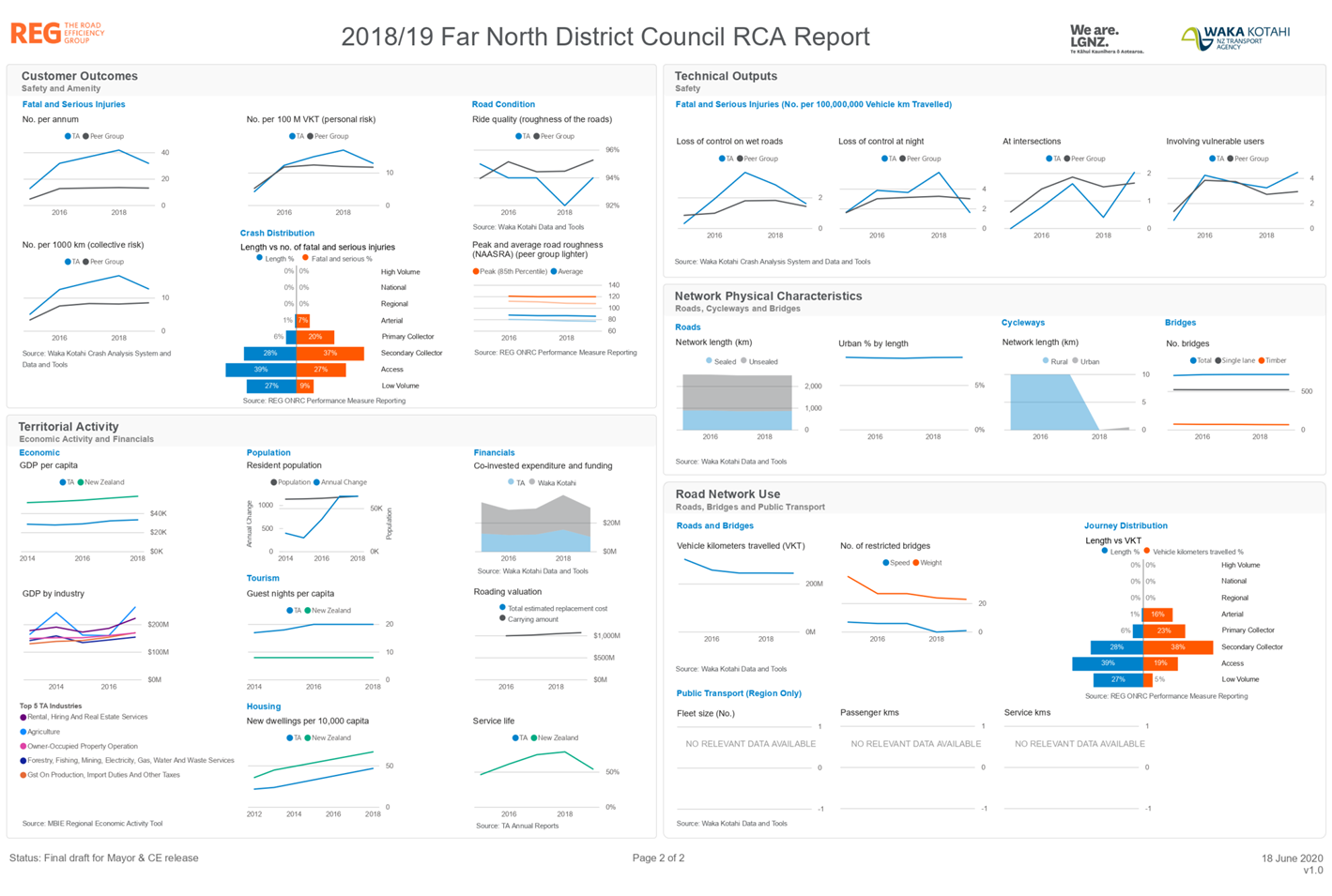
|
Infrastructure
Committee Meeting Agenda
|
9 September 2020
|


|
Infrastructure
Committee Meeting Agenda
|
9 September 2020
|


6.4 FNDC
2020/2021 Unsealed Road Upgrades and Drainage Programme
File
Number: A2947869
Author: Glenn
Rainham, Manager - Infrastructure Operations
Authoriser: Andy
Finch, General Manager - Infrastructure and Asset Management
Purpose of the Report
The purpose of this report is to present the summary of the
Unsealed Road Upgrade sites for the 2020-2021 Annual Works Plan (AWP) and
associated drainage works across the district.
Executive Summary
The Northland Transportation Alliance (NTA) has provided the
attached commentary.
|
Recommendation
That the Infrastructure Committee receive the report
FNDC 2020/2021 Unsealed Road Upgrades and Drainage Programme.
|
Background
Complaints from
road users about Far North District’s unsealed road condition early in
2019 saw the Councillor’s request an independent audit of the unsealed
roads. The General Manager - Infrastructure & Asset Management,
subsequently commissioned an independent report.
Hutchinson
Consulting Engineers (HCE) carried out an assessment of 21 carriageways
throughout the Far North District over three days from Wednesday 17th
to Friday 19th July (Attachment 2 - Report Reference L21634a).
The carriageways were independently
selected by HCE to provide as best range as possible of traffic volumes, road
classification and carriageway characteristics while ensuring an adequate
spread across the district.
During their site
observations HCE covered approximately 1,100km of the FNDC network and the
unsealed portion of the network was generally observed to be in satisfactory
condition, with majority of carriageways assessed as fit for purpose.
Where deficiencies
were observed three obvious mechanisms of pavement failure are summarised as follows:
1. Inadequate drainage;
2. Incorrect crossfall, and;
3. Insufficient pavement thickness.
HCE generally found
the maintenance works to have been completed in accordance with the contract
specification although suggesting that the methodology and frequency could be
improved.
Also, in 2019 FNDC
developed the Dust Matrix Prioritisation tool to help inform decision making of
investments for seal extensions, with dust nuisance management a key driver.
This work has been
used in the development of the 2020-2021 Annual Works Plan.
Discussion and Next Steps
The NTA has provided the attached commentary.
Financial Implications and Budgetary Provision
No additional budget requirements.
Attachments
1. 2020-2021 FNDC
Unsealed Road Upgrades and Drainage Programme - A2939669 ⇩ 
2. 2020-2021 Annual
Works Plan for Unsealed Road Upgrades and Drainage - A2939667 ⇩ 
3. HCE FNDC Unsealed
Network Audit Report_L21634a - A2939668 ⇩ 
|
Infrastructure Committee Meeting Agenda
|
9 September 2020
|
Meeting: Infrastructure
Committee 09 September 2020
Name of item: FNDC 20/21 Unsealed
Road Upgrades and Drainage Programme
Author: Aram
Goes – MTA Maintenance and Operations Manager
Date of
report: 17
August 2020
1 Purpose
The purpose of the briefing is to
present the summary of the Unsealed Road Upgrade sites for the 2020-2021 Annual
Works Plan (AWP) and associated Drainage works across the District.
2 Background
Complaints from
road users about Far North District’s unsealed road condition early in
2019 saw the Councilors request an independent audit of the unsealed
roads. The General Manager - Infrastructure & Asset Management
subsequently commissioned an independent report.
Hutchinson
Consulting Engineers (HCE) carried out an assessment of 21 carriageways
throughout the Far North District over three days from Wednesday 17th
to Friday 19th July (see Attachment 3 - Report Reference L21634a). The
carriageways were independently selected by HCE to provide as best range as
possible of traffic volumes, road classification and carriageway
characteristics while ensuring an adequate spread across the district.
During their site
observations HCE covered approximately 1,100km of the FNDC network and the
unsealed portion of the network was generally observed to be in satisfactory
condition, with the majority of carriageways assessed as fit for purpose.
Where
deficiencies were observed three obvious mechanisms of pavement failure are summarised as follows:
1. Inadequate drainage;
2. Incorrect crossfall, and;
3. Insufficient pavement thickness.
HCE generally
found the maintenance works to have been completed in accordance with the
contract specification although suggesting that the methodology and frequency
could be improved. In 2019 FNDC developed the Dust Matrix prioritization tool
to help inform decision making of investments for seal extensions, with dust
nuisance management a key driver.
3 Discussion
The
FNDC unsealed network is predominantly very low traffic volumes with:
· 92%
of the unsealed roads average daily traffic (ADT) <100 vehicles per day
(vpd);
· 98%
with ADT ranging between 100 to 200vpd, and;
· Only
2% of the unsealed roads carry traffic >200vpd.
During HCE’s site observations,
the unsealed roads generally exhibited inadequate crossfall and carriageway
shape (particularly on the exit of horizontal curves) resulting in potholes
being an obvious issue.
Other recommendations to improve the
network condition included increased attention to drainage, particularly where
notable scour is occurring at discharge points with construction of cut off
drains at the top of significant cut batters to mitigate erosion of the
embankments. Increasing the frequency and extent of roadside drainage
works in conjunction to focus on the above was a re-occurring theme.
The ‘Inspection Led’
methodology specified within the Maintenance Contracts contains mechanisms to
adjust inspections if required. Now the data for the past two years of
inspections has been obtained the process of assessing and revising inspection
frequencies can be undertaken to increase the frequency of drainage works.
Further emphasis to re-shape the
carriageway to create sufficient crossfall and super elevation by targeted
aggregate replenishment in areas where subgrade is exposed and/or high traffic
volumes are present was also recommended.
3.1 Unsealed
Road Shape and Crossfall Improvements
The Network Supervisors are
instructing the Maintenance Contractors to increase road shape by aggressive
unsealed road grading to a target 8% max to 6% min cross fall. This will
benefit in improved rain runoff and reduce the frequency of pothole occurrence.
The risk is there will be a visual
perception the roads are being narrowed and that the gravel recovered from the
outer wheel paths (and graded into the crown to achieve the desired crossfall)
may result in localized areas of subgrade material reflecting through (clay
lenses). These outer wheel paths may fail under traffic loads and require
treatment with additional maintenance gravel applications and associated
costs. Contingency has been set aside for localised on-demand spot
metalling treatments of where this occurs.
The Area Supervisors have been
creating Treatment Lengths (TLs) of the unsealed road network and a Heavy Metal
Build Up (HMBU) program has being developed to re-shape and strengthen roads
(with good crossfall and super elevation) by targeted aggregate replenishment
in areas where subgrade is exposed and/or high traffic volumes are
present.
The Annual Work Plan (AWP) for
Unsealed Road Upgrades in 2020-2021 has been set with commencement already
underway (see Attachment 2). The benefits will be a reduction in reactive
maintenance and associated costs with associated safety benefits resulting from
improved road condition, including width. The risk can be increased
traffic speeds with associated perceived safety issues.
Careful consideration to aggregate
supplies (i.e. quarry source and properties) is being applied to ensure
compliance with the technical specifications for gravel products. Based
on some gravel sources being a long distance from the sites, and associated
cartage distances seeing large loads travel long distances, effectively
‘consuming’ the road asset on-route, Contractors are being actively
encouraged to look at opening new alternative gravel sources.
Unsealed road gravels require higher
amounts of fines and plasticity (i.e. clay) to help bind the unsealed road
surfaces together for longer periods. In some instances, this results in
these gravel roads presenting themselves as “slushy” or
“slippery”, generating public complaints. We remind
stakeholders these are symptoms of unsealed road lifecycles, including the
repeat occurrence of potholes and corrugations, with routine cyclic maintenance
treatments ongoing.
3.2 Roadside
Drainage Works
The Network
Supervisors are instructing the Maintenance Contractors to increase roadside
drainage works including:
· Upgrades in culvert sizes;
· Inlet/outlet extensions;
· Headwall structures;
· Increased frequency of water table cut-outs to direct run-off out of
the water table and mitigate potential for scouring and concentrated run-off,
and;
· Scour protection i.e. placement of rock rip-rap, particularly on
steep sections of carriageway.
The benefits will be
a reduction in roadside slips that narrow the roads with drop-off hazards
however the works will likely result in an increase in drainage structures
being added to the asset base, attracting increased depreciation and
costs.
The Annual Work Plan (AWP) for
Drainage work in 2020-2021 has already been programmed (see Attachment 2) with
emphasis on ensuring sealed roads planned for resealing having all high lip
removed and proper positive longitudinal roadside drainage.
In addition, the drainage works
will also be focused to compliment the unsealed road HMBU works (item 3.1
above) with work already underway.
Note - Sealed Roads undergoing rehabilitation have
specific targeted drainage renewals funding.
3.3 Grading
with Compaction of Seasonal Peak Traffic Routes
Road users often
ask “why don’t Council always roll the roads?”
(i.e. compact them) when we grade them. The simple fact is this treatment
costs up to 5x more than routine grading and is therefore prohibitive across a
1,260km unsealed network, due to funding constraints.
Notwithstanding
this, the Roading Department has taken the initiative to target unique roads
with high summer season traffic volumes (See Attachment 2). The aim is to
compact these roads in the months leading into the Christmas and New Year
Holiday period, enabling these roads to remain intact for a longer period.
This, combined with the compacted finished surfaces of the HMBU works (Item 3.1
above), should see a significant improvement across almost 200km of unsealed
roads (15%) throughout the District.
Experience in the longevity of
compacted unsealed road surface notes the duration can be relatively
short-lived, depending on the traffic demand and environment (dry/windy) with
anywhere from 2 to 10 weeks possible, before corrugations develop (or potholes
if wet).
3.4 Application
of Unsealed Dust Suppressant (UDS)
The Roading
Department have identified 169 sections on 56 district roads that meet criteria
used to determine which routes to apply Unsealed Dust Suppressants (UDS).
The application
of the UDS totals more than 29km of the network (2%) and the treated sections
of road will not be graded post-application to prolong the life of the
product.
The roads were
selected based on having:
· Houses within 25 metres of the road;
· An average light vehicle speed on the road greater than 60kph;
· Traffic volumes of more than 130 vehicles per 24 hour period, and;
· A heavy commercial vehicle component of 20 or greater.
The compounds
used in the UDS are a temporary solution for controlling road dust and are
sprayed onto the road surface at the beginning of summer. The compounds bond with
road dust but do not make the road surface slippery and have a short lifecycle
of around three months, depending on traffic volumes and the impact of wet
weather.
4 Summary
The Roading
Department has worked over the past 12 months to segment the large unsealed
road network into definable, manageable sections (treatment Lengths) and
developed a pro-active Annual Works Plan for the physical construction of these
works.
Construction has
begun and every effort will be made to coordinate the
application of UDS to roads that have had the above HMBU and/or grading with
compaction carried out prior to being sprayed, optimising the surface finish
quality and durability of the product application.
It is
anticipated that this works programme will make a discernable change in the
quality of the unsealed road condition this summer 2020-2021.
We remind all
stakeholders that the natural behaviour of unsealed roads is highly variable
and subject to the environmental forces of nature + variable traffic
demands. Corrugations in the dry and potholes in the wet are to be
expected and the Roading Department will continue to push Contractors to
pro-actively respond and intervene to treat these defects in a timely manner.
5 Attachments
1. 2020-2021 Annual Works Plan
for Unsealed Road Upgrades and Drainage
2. Hutchinson Consulting Engineers Report Reference
L21634a
6 Report Approval
Approved by: 
Calvin Thomas - NTA Manager
18th
August 2020
|
Infrastructure
Committee Meeting Agenda
|
9 September 2020
|

|
Infrastructure Committee Meeting Agenda
|
9 September 2020
|


























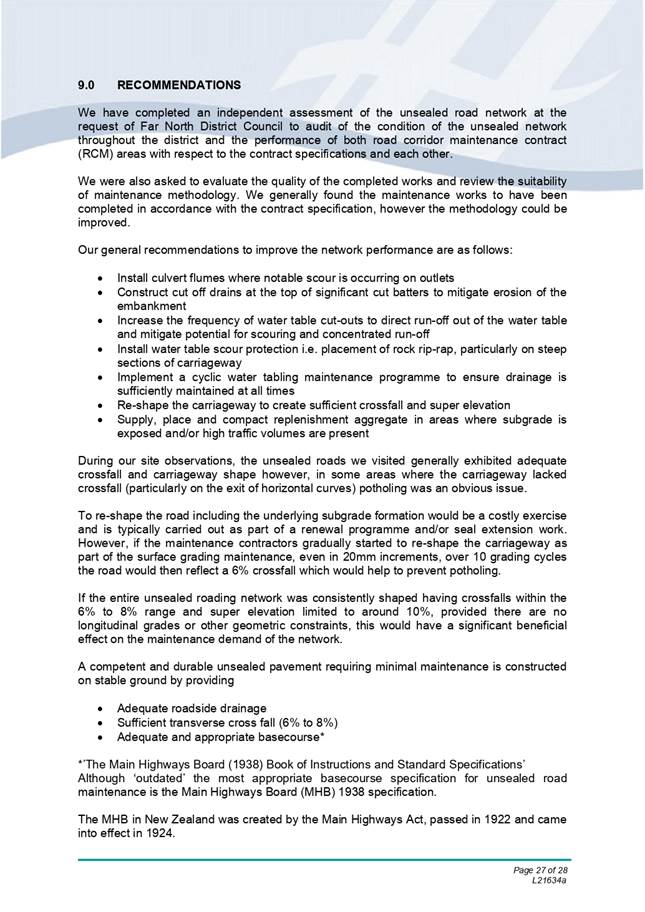




6.5 FNDC
2020/2021 Roading Capital Works and Renewals Programme
File
Number: A2947884
Author: Glenn
Rainham, Manager - Infrastructure Operations
Authoriser: Andy
Finch, General Manager - Infrastructure and Asset Management
Purpose of the Report
To provide elected
members with detail about the FNDC 2020/2021 Roading Capital Works and Renewals
programme.
Executive Summary
· The 2020/21 FNDC Capital Works and Renewals programme is being
delivered through the Northland Transportation Alliance (NTA) Capital Works
Delivery team totals $24,651,698.00 (includes 2019/20 carry forwards).
· A full delivery programme has been developed detailing the
individual projects to be undertaken through the year.
|
Recommendation
That the Infrastructure Committee receive the report
FNDC 2020/2021 Roading Capital Works and Renewals Programme.
|
Background
As detailed in the attached report prepared by the NTA.
Discussion and Next Steps
As detailed in the attached report prepared by the NTA.
Financial Implications and Budgetary Provision
There are no additional budget requirements.
Attachments
1. FNDC 2020-21
Capital Works and Renewals Programme Update - A2939802 ⇩ 
Meeting: Infrastructure
Committee 09 September 2020
Name of item: FNDC 20/21 Capital
Works and Renewals Programme Update
Author: Greg
Monteith – Capital and Procurement Manager
Date of
report: 14
August 2020
1 Purpose
To provide Elected
Members with detail pertaining to the FNDC 20/21 Capital Works and Renewals
programme.
2 Background
The 2020/21 FNDC Capital Works and
Renewals programme being delivered through the NTA Capital Works Delivery team
totals $24,651,698.00 (includes 2019/20 Carry forwards).
A full delivery programme has been developed detailing
the individual projects to be undertaken through the year. This programme
includes phasing of forecast delivery timeframes and forms the baseline measure
for reporting progress on a monthly basis through the year.
3 Discussion
A break down per funding activity is
set out below, with additional project detail contained within the following
pages of this report.
It is noted that there are items
that form part of the FNDC capital budget that are not delivered through the
capital and renewal team and thus not included in this report. These include
heavy metalling activities, drainage renewals and traffic services renewals
that our delivered through the maintenance team.

Programme
Split by project Sum of
Budget
|
125 -
Footpath Maintenance
|
612,121.00
|
|
BOI-Whangaroa Ward carry over
|
|
|
BOI-Whangaroa Ward: Various sites
|
|
|
Kaikohe-Hokianga Ward carry-over
|
|
|
Kaikohe-Hokianga Ward: Various sites
|
|
|
Te Hiku Ward carry-over
|
|
|
Te Hiku Ward: Various Sites
|
|
|
|
|
|
New Footpaths - Unsubsidised
|
211,770.61
|
|
BOI-Whangaroa Ward: SH11 Kaipatiki Rd to
York Rd
|
|
|
Kaikohe-Hokianga Ward: Kohukohu Road
Manning to Marriner
|
|
|
Kaikohe-Hokianga Ward: Placeholder -
Community Board to advise
|
|
|
Te Hiku Ward: Foreshore Rd - Tasman Heights
to Toilets
|
|
|
|
|
|
Footpath Renewal Unsubsidised
|
93,941.00
|
|
SH12 Opononi
|
|
|
|
|
|
MBIE Redeployment Package – Missing Link New Footpath
Sections
|
621,000.00
|
|
BOI-Whangaroa Ward: Length of Blacks Road
|
|
|
Kaikohe-Hokianga Ward: Kaikohe Footpath
Signal Station Rd, Omapere
|
|
|
Te Hiku Ward: Donald Ln to WINZ on N Park
Drive
|
|
|
Te Hiku Ward: Foreshore Road, Taipa
|
|
|
Te Hiku Ward: Mamaru Road
|
|
|
Te Hiku Ward: Point Road, Taipa
|
|
|
|
|
|
Cycle Trail Unsubsidised
|
96,903.00
|
|
Pou Herenga Tai Cycle Trail NZ Heritage
|
|
|
|
|
|
140 - Minor Events – General Maintenance
|
225,544.00
|
|
Kohomaru Rd Mitigation Works - (Balance of
Carry-over from 2019/20)
|
|
|
Rawhiti Rd
|
|
|
Waikare Road - various locations
|
|
|
|
|
|
141 - Emergency Works - Resilience
|
652,718.00
|
|
Diggers Valley Rd – Slip Repairs
|
|
|
Fairburn Rd – Slip Repairs
|
|
|
West Coast Rd RP 9563 – Slip Repairs
|
|
|
Wharekawa Rd RP 3552 – Construct
retaining wall and reinstate carriageway
|
|
|
|
|
|
212 - Sealed Road Resurfacing
|
3,527,796.00
|
|
North region (Chip Seal - 31.4km, AC -
0.632km)
|
|
|
South Region (Chip Seal -37.99km)
|
|
|
214 - Sealed Road pavement rehabilitation
|
3,275,029.00
|
|
Broadwood road
|
|
|
Horeke Road
|
|
|
OKAIHAU ROAD
|
|
|
PAWARENGA ROAD
|
|
|
Pungaere Road
|
|
|
Purerua Road
|
|
|
WAIMATENUI / MATARAUA ROAD
|
|
|
Rehab design and investigation 21/22 sites
|
|
|
|
|
|
215 – Structures (Bridges) Component Replacement
|
2,328,283.00
|
|
Churtons Road Bridge C13
|
|
|
General Bridge maintenance
|
|
|
Grove Road Bridge M28
|
|
|
Heavy Bridge Maintenance (Nth & Sth)
|
|
|
Hihi Road Bridge F07
|
|
|
Kaitaia Awaroa road bridge D42
|
|
|
Kaitaia Awaroa road bridge D47
|
|
|
Kenana Road Culvert E94
|
|
|
Mangamuka Road Culvert H40
|
|
|
Matai Bay Road Bridge C03
|
|
|
Matawherohia Road & Puhata road
|
|
|
Scour protection (North and South)
|
|
|
Contingency for any overruns and testing,
designing for next FY
|
|
|
|
|
|
341 - Low Cost Low Risk (LCLR)
|
11,107,118.39
|
|
341 LCLR - Associated
Improvements
|
443,659.00
|
|
Northern & Southern Area: Associated
improvements on 2020/21 pavement rehabilitation
sites
|
|
|
|
341 LCLR - Bridge Works
|
1,399,626.00
|
|
Kaitaia-Awaroa Road Culvert D41 Replacement
|
|
|
Otaua Road M28 N28
|
|
|
Puhata Road Bridge D50 Replacement
|
|
|
Quarry Road (Awanui) Culvert B13
Replacement
|
|
|
WekaWeka Road Culvert J18 Replacement
|
|
|
West Coast Road G01
|
|
|
|
|
|
341 LCLR - Future designs
|
552,008.00
|
|
Various locations
|
|
|
|
|
|
341 LCLR - Lighting
|
1,641,312.00
|
|
Various District Roads including 19/20
carry over – LED light upgrade
|
|
|
|
|
|
341 LCLR - New Footpaths
|
1,013,918.39
|
|
BOI-Whangaroa Ward: Length of Pa Road
|
|
|
BOI-Whangaroa Ward: Ped Bridge near Main St
Bridge
|
|
|
BOI-Whangaroa Ward: SH11 Kaipatiki Rd to
York Rd
|
|
|
BOI-Whangaroa Ward: Te Taipui Rd to Matauri
Bay School Link
|
|
|
Kaikohe-Hokianga Ward: Horeke Rd to
Cemetery 294-330
|
|
|
Kaikohe-Hokianga Ward: Kaikohe Footpath -
Taheke Road to Orrs Road
|
|
|
Kaikohe-Hokianga Ward: Kohukohu Road
Manning to Marriner
|
|
|
Kaikohe-Hokianga Ward: Lake Road 91 to 95
|
|
|
Kaikohe-Hokianga Ward: Opononi Footpath -
Waianga Place
|
|
|
Kaikohe-Hokianga Ward: Taumataiwi St
Opononi
|
|
|
North Park Drive - Whangatane Drive,
Kaitaia
|
|
|
Te Hiku Ward: Foreshore Rd - Tasman Heights
to Toilets
|
|
|
Te Hiku Ward: Foreshore Road - Toilets to
Panorama Lane
|
|
|
Te Hiku Ward: Kaitaia - Dominion Road
|
|
|
Te Hiku Ward: Kaitaia - SH1 Matthews Avenue
|
|
|
Te Hiku Ward: Mill Bay Rd Rangikapiti Rd to
Richmond Rd link
|
|
|
Te Hiku Ward: Mill Bay Rd to Rangikapiti Rd
|
|
|
Te Hiku Ward: SH1 Harbour View Rd to
private access
|
|
|
|
|
|
341 LCLR - Resilience
|
2,878,907.00
|
|
Kaitaia Awaroa 26991 (c/o from 19/20
currently in construction)
|
|
|
Long Beach Rd
RP 294 - Construct a retaining wall and reinstate the edge of carriageway on
Long Beach Rd
|
|
Mangamuka Road RP 7845 & 8387
|
|
|
Sullivans Road - Construct a retaining wall
and reinstate the edge of carriageway
|
|
|
Taupo Bay Road RP 8816 & 9169 –
Slip repairs
|
|
|
Waikare Road - mitigation contract (c/o
from 19/20 currently in construction)
|
|
|
Wainui Road RP 7200 - Construct a retaining
wall and reinstate the edge of carriageway
|
|
|
West Coast Rd RP16005 – Slip repairs
|
|
|
Wharekawa Rd RP
3633 - Construct a retaining wall and reinstate the edge of carriageway
|
|
Panguru Road
Raising/ Flood Mitigation - Raising 4 x sections of West Coast Road - South
of Panguru
|
|
Various Design/Assessment for 21/22
projects.
|
|
|
|
|
|
341 LCLR - Safety
|
1,147,688.00
|
|
Kaitaia-Awaroa
Rd RP3200 - Installation of guardrails
|
|
|
Kaitaia-Awaroa
Rd RP5690 - Installation of guardrails
|
|
|
Route 1 Kaitaia - Ahipara (Kaitaia Awaroa Rd)
-
Installation of guardrails at several locations
-
Corridor wide warning sign installations on Kaitaia Awaroa Road
|
|
Route 2 Puketona Junction - Ohaewai (Te AhuAhu & Old Bay Roads)
-
Installation of road safety signs along Te AhuAhu & Old Bay Roads
|
|
|
Route 4 Kerikeri-Okaihau
-
Installation of road safety signs along Wiroa Rd, Waiare Rd, Wehirua Rd &
Kerikeri Rd
|
|
Route 5 Taipa-Kaitaia
-
Installation of road safety signs along Oruru Rd, Fairburn Rd & Peria Rd
|
|
|
Route 7 Matauri Bay Loop Roads
-
Installation of road safety signs along Matauri Bay Loop Roads
|
|
|
|
|
|
341 LCLR - Speed
|
280,000.00
|
|
Okaihau Triangle between SH1, SH10 and the Mungamuka's
–
Safety improvements associated with proposed speed changes
|
|
|
|
|
|
341 LCLR - Seal Extension -
Subsidised
|
1,750,000.00
|
|
Church Rd RP 13317 - 15017
|
|
|
Koropewa Rd RP 15 - 1833
|
|
|
|
|
|
Seal Extension - Unsubsidised
|
1,185,264.00
|
|
Seal Extension
|
|
|
Balance of carry-over amount from 2019/20
|
|
|
- Porotu Rd RP 0 - 1380
|
|
|
- Puketi Rd RP 0 - 1000
|
|
|
|
|
|
Resilience - Unsubsidised
|
204,000.00
|
|
Unsubsidised Panguru allocation
|
|
|
|
|
|
Special 100% FAR
|
357,368.00
|
|
New Footpath
|
|
|
Tau Henare Drive - Waitangi Trust
- Construct new path on Tau Henare Drive from the one lane
bridge to the treaty grounds
|
|
Sealing Chip seal
|
|
|
Waitangi Trust for Tau Henare Drive Sealing
(south region)
|
|
Report
Approval
Approved by: 
Calvin Thomas - NTA Manager
18th
August 2020
6.6 FNDC
Infrastructure & Asset Management (IAM) Business Report for July 2020
File Number: A2939811
Author: Tania
George, EA to GM - Infrastructure and Asset Management
Authoriser: Andy Finch, General Manager - Infrastructure and Asset Management
Purpose of the Report
To
present a summary of Infrastructure and Asset Management activity and
information items.
Executive Summary
The
Infrastructure and Asset Management Update provides an overview of
Infrastructure and Asset Management activity for the period of July 2020.
|
Recommendation
That the Infrastructure Committee
receive the report FNDC Infrastructure & Asset Management (IAM) Business
Report for July 2020.
|
Background
This report presents a range of performance and interest
items focussed around Council Infrastructure.
Discussion and Next Steps
The information is attached in the form of a report.
Financial Implications and
Budgetary Provision
None
Attachments
1. Attachment
1 - IAM Business Report as at 31 July 2020 - A2940990 ⇩ 
|
Infrastructure Committee Meeting Agenda
|
9 September 2020
|














7 Public
Excluded
RESOLUTION TO
EXCLUDE THE PUBLIC
|
Recommendation
That the public be excluded from the following parts of
the proceedings of this meeting.
The general subject matter of each matter to be considered
while the public is excluded, the reason for passing this resolution in
relation to each matter, and the specific grounds under section 48 of the
Local Government Official Information and Meetings Act 1987 for the passing
of this resolution are as follows:
|
General subject of each matter to be
considered
|
Reason for passing this resolution in
relation to each matter
|
Ground(s) under section 48 for the
passing of this resolution
|
|
7.1 - Northern Animal Shelter
|
s7(2)(i) - the withholding of the information is
necessary to enable Council to carry on, without prejudice or disadvantage,
negotiations (including commercial and industrial negotiations)
|
s48(1)(a)(i) - the public conduct of the relevant
part of the proceedings of the meeting would be likely to result in the
disclosure of information for which good reason for withholding would exist
under section 6 or section 7
|
|

























































